Este tema está marcado actualmente como "inactivo"—el último mensaje es de hace más de 90 días. Puedes reactivarlo escribiendo una respuesta.
1Sopoforic
Hello, my comrades in this challenge!
This is my first time participating in this particular challenge, though I've attempted others like it before. Most of what I read, lately, seems to be electronic and largely short-form (Confession: since I started keeping track in mid-2011, I've averaged over 30k pages of fanfiction per year. Ghastly!), so I hope to use this to motivate me to read more 'real' books, and work my way through some of my TBR pile.
I'll be 'customizing' this challenge a bit, because when I've tried to make myself read more 'real' books in the past, I ended up reading a lot of picture books near the end of the year to get my numbers up. No cheating this time! Instead, I'll keep two counts: one of 'real' books, and the other for picture books, substantial essays, or other interesting things that don't quite fit.
What I'm likely to read: some classics, some poetry, and scifi and fantasy should figure in. Depending on how industrious I'm feeling, you may see philosophy make an appearance. There may also be more children's, middle grade, and YA stuff than I'd like to admit. And of course I'm likely to veer wildly off course when I stumble onto something interesting, but that's the joy of reading, am I right?
Since pictures seem to be in style, have a (rather grainy, I fear) preview of a few of the things I hope to get to, this year. No points for guessing that the thinner books are more likely to be read.

Initial books to follow...
This is my first time participating in this particular challenge, though I've attempted others like it before. Most of what I read, lately, seems to be electronic and largely short-form (Confession: since I started keeping track in mid-2011, I've averaged over 30k pages of fanfiction per year. Ghastly!), so I hope to use this to motivate me to read more 'real' books, and work my way through some of my TBR pile.
I'll be 'customizing' this challenge a bit, because when I've tried to make myself read more 'real' books in the past, I ended up reading a lot of picture books near the end of the year to get my numbers up. No cheating this time! Instead, I'll keep two counts: one of 'real' books, and the other for picture books, substantial essays, or other interesting things that don't quite fit.
What I'm likely to read: some classics, some poetry, and scifi and fantasy should figure in. Depending on how industrious I'm feeling, you may see philosophy make an appearance. There may also be more children's, middle grade, and YA stuff than I'd like to admit. And of course I'm likely to veer wildly off course when I stumble onto something interesting, but that's the joy of reading, am I right?
Since pictures seem to be in style, have a (rather grainy, I fear) preview of a few of the things I hope to get to, this year. No points for guessing that the thinner books are more likely to be read.

Initial books to follow...
2Sopoforic
Book 1: A Boy's Will by Robert Frost (1913, 63 pp.)

Read January 7-8.
Of course I'd read a few poems by Robert Frost at some point during my life, but I wanted to get a little more familiar with poetry in general and Frost in particular, so I decided to begin at the beginning. There are some lovely poems in here, though perhaps none are my particular favorites.
"My November Guest" is wonderfully easy to read (i.e. the rhythm is natural--the interpretation is not quite so simple!) and felt as appropriate in January as November.
"The Tuft of Flowers", too, I especially liked. I read in it the transformative power of experience, as, in the space of a few lines, the speaker goes from:
to:
It's a lovely poem, indeed.
Other Reading I: "My Winter-Garden" by Charles Kingsley
I came across this essay in the April 1858 issue of Fraser's Magazine. In it, Kingsley praises the joys of the simple (if monotonous) life, as opposed to adventure and travel:
Most of the essay is a tale of a fox hunt, described very thoroughly, though with many digressions. Kingsley's writing, even about simple things, is entertaining. For example, when writing of riding through Scotch firs:
I've never before read anything by Charles Kingsley, but I think I'll add his Hypatia to my TBR list--which means I may read it this century, if all goes well.

Read January 7-8.
Of course I'd read a few poems by Robert Frost at some point during my life, but I wanted to get a little more familiar with poetry in general and Frost in particular, so I decided to begin at the beginning. There are some lovely poems in here, though perhaps none are my particular favorites.
"My November Guest" is wonderfully easy to read (i.e. the rhythm is natural--the interpretation is not quite so simple!) and felt as appropriate in January as November.
"The Tuft of Flowers", too, I especially liked. I read in it the transformative power of experience, as, in the space of a few lines, the speaker goes from:
But he had gone his way, the grass all mown,
And I must be, as he had been,--alone,
'As all must be,' I said within my heart,
'Whether they work together of apart.'
to:
And feel a spirit kindred to my own;
So that henceforth I worked no more alone;
But glad with him, I worked as with his aid,
And weary, sought at noon with him the shade;
And dreaming, as it were, held brotherly speech
With one whose thought I had not hoped to reach.
'Men work together,' I told him from the heart,
'Whether they work together or apart.'
It's a lovely poem, indeed.
Other Reading I: "My Winter-Garden" by Charles Kingsley
I came across this essay in the April 1858 issue of Fraser's Magazine. In it, Kingsley praises the joys of the simple (if monotonous) life, as opposed to adventure and travel:
Besides, monotony is pleasant in itself; morally pleasant, and morally useful. Marriage is monotonous: but there is much, I trust, to be said in favour of holy wedlock. Living in the same house is monotonous: but three removes, say the wise, are as bad as a fire.
…
Pleasant and good it is to ride the same horse, to sit in the same chair, to wear the same old coat. That man who offered twenty pounds reward for a lost carpet bag full of old boots was a sage, and I wish I knew him. Why should one change one’s place, any more than one’s wife or one’s children? Is a hermit-crab, slipping his tail out of one strange shell into another, in the hopes of its fitting him a little better, either a dignified, safe, or graceful animal?
…
It is an easy philosophy; especially in the case of the horse, where a man cannot afford more than one, as I cannot. To own a stud of horses, after all, is not to own horses at all, but riding-machines. Your rich man who rides Crimoea in the morning, Sir Guy in the afternoon, and Sultan to-morrow, and something else the next day, may be a very gallant rider: but it is a question of whether he enjoys the pleasure which one horse gives to the poor man who rides him day after day; one horse, who is not a slave, but a friend; who has learnt all his tricks of voice, hand, heel, and knows what his master wants, even without being told; who will bear with his masters infirmities, and feels secure that his master will bear with his in turn.
Most of the essay is a tale of a fox hunt, described very thoroughly, though with many digressions. Kingsley's writing, even about simple things, is entertaining. For example, when writing of riding through Scotch firs:
Stiff are those Scotchmen, and close and stout they stand by each other, and claw at you as you twist through them, the biggest aiming at your head, or even worse, at your knees; while the middle-sized slip their brushes between your thigh and the saddle, and the little babies tickle your horse's stomach, or twine about his fore-feet. Whish--whish; I am enveloped in what seems an atmosphere of scrubbing-brushes. Fain would I shut my eyes: but dare not, or I shall ride against a tree. Whish--whish; alas for the horse which cannot wind and turn like a hare! Hounds, huntsmen, all are invisible; only by the swishing and crashing of boughs right and left do I know that there are a dozen men in the same torment as I, and calling it, after the manner of Englishmen, sport.
Plunge--stagger. What is this? A broad line of ruts; perhaps some Celtic trackway, two thousand years old, now matted over with firs; dangerous enough out on the open moor, when only masked by a line of higher and darker heath: but doubly dangerous now when masked by dark undergrowth. You must find your own way here, mare. I will positively have nothing to do with it. I disclaim all responsibility. There are the reins on your neck; do what you will, only do something--and if you can, get forward, and not back.
There is daylight at last, and fresh air. We gallop contemptuously through the advanced skirmishers of the Scotch invading army; find a practicable trackway through a long dreary yellow bog, too wet for first to root in, and are away again 'a streamer'.
I've never before read anything by Charles Kingsley, but I think I'll add his Hypatia to my TBR list--which means I may read it this century, if all goes well.
3drneutron
Welcome! You've got some great books in your pic. I'll be back to see what you're reading.
4Sopoforic
Whew! It took a few days, but I finished the next book.
Book 2: North of Boston by Robert Frost (1914, 143 pp.)
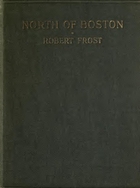
Read January 7-February 15.
This is Frost's second book of poetry. It contains much longer poems, on average, than A Boy's Will, but honestly I'm not as happy with it. First, though, let me pick out a selection from a poem that I enjoyed.
"The Death of the Hired Man" is probably my single favorite poem in the book, less because of pretty words and more because of how effectively the story is told. In short, Silas, a man in past times hired by Warren to help on his farm, has returned, in the Winter, in a bad way. Warren is upset, because Silas had left when he was needed, seeking better wages. Warren's wife, Mary, scolds him for being cold:
In the end (it's no surprise, given the title) Silas does die, and that's it. Though Silas doesn't speak, in the poem, Mary speaks for him, relaying his words and interpreting his thoughts. The poem reflects on a number of things: the relationship between Silas and his employers; what obligations they have toward one another; particularly, the 'obligation' of one's home to take one in; and, the sort of concerns a man has, as he comes to his death.
As I said, I wasn't as happy with this book as I was with A Boy's Will. I can't say for sure that the average poem North of Boston is any worse than the average poem in that book, but I think that North of Boston manages somehow to be less than the sum of its parts. The poems share some common themes among them, but they don't build upon the themes, or explore them in a way to give you a fuller picture, so revisiting the themes feels more like repeating a thought than expanding upon it.
Too, some of the poems go on too long--not because of any general preference on my part for short poetry, but because they exhaust the points they're trying to make well before they run out of words with which to make them.
Finally, the poems in this book, like "The Death of the Hired Man", are mostly dialogues. The speakers in several of the poems have voices very similar to my ear, which is especially damaging, as it makes the feeling of a poem gone on too long carry over from one to another in a most unfortunate fashion. It's perhaps unfair of me--had I read the poems spaced far apart I might have considered them each individually better--but I cannot help what I feel.
All right, enough of Robert Frost, for now. I'd wanted to finish this book, before reading much else, but poetry takes a while for me. Not that it takes so long to read, but I take a long time after reading with the poems turning over in my head, which accounts for the month I spent 'reading' this book--it was time that the poems in this and the previous book were percolating through my mind.
I'll read something a bit lighter, next. I've made a start on Born to Run by Mercedes Lackey and Larry Dixon, and I'd like to read Andre Norton's Dark Piper, too. Anything less melancholy than Robert Frost!
Book 2: North of Boston by Robert Frost (1914, 143 pp.)

Read January 7-February 15.
This is Frost's second book of poetry. It contains much longer poems, on average, than A Boy's Will, but honestly I'm not as happy with it. First, though, let me pick out a selection from a poem that I enjoyed.
"The Death of the Hired Man" is probably my single favorite poem in the book, less because of pretty words and more because of how effectively the story is told. In short, Silas, a man in past times hired by Warren to help on his farm, has returned, in the Winter, in a bad way. Warren is upset, because Silas had left when he was needed, seeking better wages. Warren's wife, Mary, scolds him for being cold:
"Warren," she said, "he has come home to die:
You needn't be afraid he'll leave you this time."
"Home," he mocked gently.
"Yes, what else but home?
It all depends on what you mean by home.
Of course he's nothing to us, any more
Than was the hound that came a stranger to us
Out of the woods, worn out upon the trail."
"Home is the place where, when you have to go there,
They have to take you in."
"I should have called it
Something you somehow haven't to deserve."
In the end (it's no surprise, given the title) Silas does die, and that's it. Though Silas doesn't speak, in the poem, Mary speaks for him, relaying his words and interpreting his thoughts. The poem reflects on a number of things: the relationship between Silas and his employers; what obligations they have toward one another; particularly, the 'obligation' of one's home to take one in; and, the sort of concerns a man has, as he comes to his death.
As I said, I wasn't as happy with this book as I was with A Boy's Will. I can't say for sure that the average poem North of Boston is any worse than the average poem in that book, but I think that North of Boston manages somehow to be less than the sum of its parts. The poems share some common themes among them, but they don't build upon the themes, or explore them in a way to give you a fuller picture, so revisiting the themes feels more like repeating a thought than expanding upon it.
Too, some of the poems go on too long--not because of any general preference on my part for short poetry, but because they exhaust the points they're trying to make well before they run out of words with which to make them.
Finally, the poems in this book, like "The Death of the Hired Man", are mostly dialogues. The speakers in several of the poems have voices very similar to my ear, which is especially damaging, as it makes the feeling of a poem gone on too long carry over from one to another in a most unfortunate fashion. It's perhaps unfair of me--had I read the poems spaced far apart I might have considered them each individually better--but I cannot help what I feel.
All right, enough of Robert Frost, for now. I'd wanted to finish this book, before reading much else, but poetry takes a while for me. Not that it takes so long to read, but I take a long time after reading with the poems turning over in my head, which accounts for the month I spent 'reading' this book--it was time that the poems in this and the previous book were percolating through my mind.
I'll read something a bit lighter, next. I've made a start on Born to Run by Mercedes Lackey and Larry Dixon, and I'd like to read Andre Norton's Dark Piper, too. Anything less melancholy than Robert Frost!
5Sopoforic
Also, hello, drneutron, and thanks for stopping by! I hope I can provide some entertainment.
6Sopoforic
And, hot on the heels of North of Boston I've finished another!
Book 3: Born to Run by Mercedes Lackey and Larry Dixon (1992, 336 pp.)

I said, last time, that I'd read something a bit lighter than Robert Frost next. Naturally, I picked the one fantasy novel I can think of that is about child abuse. I knew what it was about when I started, I just wasn't thinking...
Born to Run is urban fantasy. The premise is that elves and banshees and various creatures and circumstances of the Irish and Scottish mythology are real. The good elves are relatively well-disposed toward humans, and will generally help people, and the bad ones hate humans and will try to do them harm. The modernization of this basic story is that the good elves, led by Keighvin Silverhair, are building racecars in order to get money to help children, since in the modern world magically-created gold isn't so useful, while the bad elves (and other creatures of the Unseleighe Court) are running a business creating kiddie porn and snuff films, enjoying both the monetary profit and the negative emotions.
The story plays out in the lives of the elves of Elfhame Fairgrove, the human mage Tannim, the retired metallurgist Sam Kelly, and the teenage runaway and prostitute Tania.
I like this modernization of the mythology. It serves as a great basis for the story, and it's an interesting enough setting to hold the reader's attention.
Unfortunately, the writing wasn't so good. It was very heavy-handed. I'd even call it amateurish, in many ways. The foreshadowing is obvious enough that they might as well have just said "check back in a hundred pages when this plot thread ties into the others".
In particular, it was totally obvious from the beginning that Ross would be helping out in the climax ("You need me, you call."), that Tania would be rescued by Tannim ("She had vague memories of a dream, where Tannim was some kind of warrior, in leather and blue jeans, and he fought monsters to protect her. . . ."), that the bad guys who make kiddie porn would use Tania in their plot against the good guys... and so on. It would have been far more surprising if those things hadn't happened. Even the character of Skippy-Rob was pretty obviously set up as someone we should miss when he died--someone to die to show us how serious things are.
Besides the plot-related issues, the book feels very like reading fanfiction--regular references to popular culture and scifi/fantasy literature. As for the former, being published in 1992, it's very firmly set in a late-eighties/early-nineties cultural milieu, which is probably a little more jarring now than it was twenty years ago. As for the latter, the only other book I can think of that made quite so many scifi references was Inferno by Niven and Pournelle, but it had a pretty good reason for it. Born to Run also ignores the Law of Conservation of Detail at odd moments, devoting, for example, two large paragraphs to describing Tannim's bed. Those kinds of things can add character to a work, when done well, but they just felt out of place here.
The heavy-handedness I mentioned comes through not just in the foreshadowing, but in the moralizing the book engages in. The most substantial theme of the book is that there are children in very bad circumstances, forced to live as no child should, and that this is a real problem. True and important. But they try too hard, I think, to convince us. A relevant quotation:
Sam, being one of the good guys, comes around pretty quickly (he decides that elves are probably pretty hard to trick). I recognize that the authors are intentionally trying to head off the kinds of arguments people make in the real world, by having them countered in the story, but it still feels clumsy. And it's far from the only time in the novel when there's a scene that is almost certainly only present to counter some misconception that the readers may have.
I've said a lot of bad things about this book, but that doesn't mean I didn't like it. I'll probably read the others in the series, some time, and I'd even recommend the book--if you think it sounds interesting, you'll probably not be disappointed if you read it. Just don't expect a masterpiece. The plot is engaging enough, and it's not hard to care about what happens to the characters, particularly in Tania's segments.
I enjoyed Lackey's Valdemar series much more, but this book is a pretty solid 3/5, in my opinion.
Upcoming: I've begun reading Dark Piper by Andre Norton. I'm only a chapter in, but I'm feeling pretty positive about it, so far. I might try I, Claudius, after that, for a change of pace.
Book 3: Born to Run by Mercedes Lackey and Larry Dixon (1992, 336 pp.)

I said, last time, that I'd read something a bit lighter than Robert Frost next. Naturally, I picked the one fantasy novel I can think of that is about child abuse. I knew what it was about when I started, I just wasn't thinking...
Born to Run is urban fantasy. The premise is that elves and banshees and various creatures and circumstances of the Irish and Scottish mythology are real. The good elves are relatively well-disposed toward humans, and will generally help people, and the bad ones hate humans and will try to do them harm. The modernization of this basic story is that the good elves, led by Keighvin Silverhair, are building racecars in order to get money to help children, since in the modern world magically-created gold isn't so useful, while the bad elves (and other creatures of the Unseleighe Court) are running a business creating kiddie porn and snuff films, enjoying both the monetary profit and the negative emotions.
The story plays out in the lives of the elves of Elfhame Fairgrove, the human mage Tannim, the retired metallurgist Sam Kelly, and the teenage runaway and prostitute Tania.
I like this modernization of the mythology. It serves as a great basis for the story, and it's an interesting enough setting to hold the reader's attention.
Unfortunately, the writing wasn't so good. It was very heavy-handed. I'd even call it amateurish, in many ways. The foreshadowing is obvious enough that they might as well have just said "check back in a hundred pages when this plot thread ties into the others".
Besides the plot-related issues, the book feels very like reading fanfiction--regular references to popular culture and scifi/fantasy literature. As for the former, being published in 1992, it's very firmly set in a late-eighties/early-nineties cultural milieu, which is probably a little more jarring now than it was twenty years ago. As for the latter, the only other book I can think of that made quite so many scifi references was Inferno by Niven and Pournelle, but it had a pretty good reason for it. Born to Run also ignores the Law of Conservation of Detail at odd moments, devoting, for example, two large paragraphs to describing Tannim's bed. Those kinds of things can add character to a work, when done well, but they just felt out of place here.
The heavy-handedness I mentioned comes through not just in the foreshadowing, but in the moralizing the book engages in. The most substantial theme of the book is that there are children in very bad circumstances, forced to live as no child should, and that this is a real problem. True and important. But they try too hard, I think, to convince us. A relevant quotation:
Sam nodded, but he had reservations. Not that he hadn’t heard about all the supposed abused kids, on everything from Oprah to prime-time TV dramas, but he wasn’t sure he believed the stories. Kids made things up, when they thought they were in for deserved punishment. Hell, one of the young guys at work had shown up with a story about his kid getting into something he was told to leave alone in a store, breaking it, then launching into screams of “don’t beat me, Mommy!” when the mother descended like a fury. Embarrassed the blazes out of her, especially since the worst she’d ever delivered in the kid’s life was a couple of smacks on the bottom. Turned out the brat had seen a dramatized crime-recreation show the night before, with an abused-kid episode. Sam was beginning to think that a lot of those “beaten kids” had seen similar shows, then had been coached by attorneys, “child advocates,” or the “non-abusing spouse.” Wasn’t that how the Salem witch-trials had happened, anyway? A bunch of kids getting back at the adults they didn’t like?
Sam, being one of the good guys, comes around pretty quickly (he decides that elves are probably pretty hard to trick). I recognize that the authors are intentionally trying to head off the kinds of arguments people make in the real world, by having them countered in the story, but it still feels clumsy. And it's far from the only time in the novel when there's a scene that is almost certainly only present to counter some misconception that the readers may have.
I've said a lot of bad things about this book, but that doesn't mean I didn't like it. I'll probably read the others in the series, some time, and I'd even recommend the book--if you think it sounds interesting, you'll probably not be disappointed if you read it. Just don't expect a masterpiece. The plot is engaging enough, and it's not hard to care about what happens to the characters, particularly in Tania's segments.
I enjoyed Lackey's Valdemar series much more, but this book is a pretty solid 3/5, in my opinion.
Upcoming: I've begun reading Dark Piper by Andre Norton. I'm only a chapter in, but I'm feeling pretty positive about it, so far. I might try I, Claudius, after that, for a change of pace.
7Sopoforic
An interlude! A picture book.
Other Reading II: Cherries and Cherry Pits by Vera B. Williams (1986, 36 pp.)

The book opens:

The narrator spends the rest of the book with Bidemmi, who tries out her new marker. As she draws, Bidemmi tells stories about what she's drawing. "THIS is the door to the subway..." she begins, and tells a story about a man who brings a bag of cherries home to his children, which they eat, and spit out the pits.
Then another picture, and another story: "THIS is the train seat. And THIS is a tiny white woman sitting on the train seat..." begins a story about a woman who returns to her little one-room home with a bag of cherries, which she shares with her pet parrot, and they spit out the pits.
Another picture, another story: "THIS is a shoelace. And THIS is a running shoe. It's going to be purple and white..." begins a story about a boy (who "looks a lot like my brother", "is tall like my brother", "has glasses like my brother", "And when he smiles you can see the space between his big front teeth like my brother's.") who brings a cherry home to his little sister, and warns her not to forget to spit out the pit.

Finally, she begins another picture, and another story, to tie them all together: "THIS is me. And THIS is my station. I have to walk up the stairs one at a time..." begins a story about Bidemmi buying a bag of cherries, and eating them on her way home--and saving the pits. When she gets home, she plants the pits, which grow ever so slowly: "And all the time, cherries will be growing right under these leaves, so tiny and green no one even notices them. But I work hard. I come out every single day to chase away the blue jays that are trying to steal the cherries. I chase away the dogs that try to use the yard for their business and the kids who try to carve initials on the tree."
Finally, the cherries are ripe, and her neighbors come out: "There are enough cherries for every single one of them. And even for their friends from Nairobi and Brooklyn, Toronto and St. Paul, who come down in these airplanes." They eat the cherries and spit out the pits and "THIS cherry pit and THIS cherry pit and all the cherry pits start to grow until there is a whole forest of cherry trees right on our block."
This is a lovely little picture book. The frame story is illustrated in watercolors, and the drawings that Bidemmi makes to illustrate the stories she tells are done in marker. The book actually ends with a nice picture of watercolor-Bidemmi standing beside marker-Bidemmi, which I should have scanned, but didn't. Sorry! I do hate opening books up wide to scan them, and I believe I've abused this one enough.
Anyway, this was a fun read, and good for me since I needed something simple and pleasant, after the last couple of books. Picture books are wonderful, since they're exactly what it says on the tin: art and stories together. Something you can enjoy in several different ways, and short enough to read whenever you like, too!
Other Reading II: Cherries and Cherry Pits by Vera B. Williams (1986, 36 pp.)

The book opens:
Bidemmi lives on the floor above me. We visit back and forth a lot. Bidemmi loves to draw, so when she opens the door I'm often standing there with a marker of some kind or color she doesn't have yet.

The narrator spends the rest of the book with Bidemmi, who tries out her new marker. As she draws, Bidemmi tells stories about what she's drawing. "THIS is the door to the subway..." she begins, and tells a story about a man who brings a bag of cherries home to his children, which they eat, and spit out the pits.
Then another picture, and another story: "THIS is the train seat. And THIS is a tiny white woman sitting on the train seat..." begins a story about a woman who returns to her little one-room home with a bag of cherries, which she shares with her pet parrot, and they spit out the pits.
Another picture, another story: "THIS is a shoelace. And THIS is a running shoe. It's going to be purple and white..." begins a story about a boy (who "looks a lot like my brother", "is tall like my brother", "has glasses like my brother", "And when he smiles you can see the space between his big front teeth like my brother's.") who brings a cherry home to his little sister, and warns her not to forget to spit out the pit.

Finally, she begins another picture, and another story, to tie them all together: "THIS is me. And THIS is my station. I have to walk up the stairs one at a time..." begins a story about Bidemmi buying a bag of cherries, and eating them on her way home--and saving the pits. When she gets home, she plants the pits, which grow ever so slowly: "And all the time, cherries will be growing right under these leaves, so tiny and green no one even notices them. But I work hard. I come out every single day to chase away the blue jays that are trying to steal the cherries. I chase away the dogs that try to use the yard for their business and the kids who try to carve initials on the tree."
Finally, the cherries are ripe, and her neighbors come out: "There are enough cherries for every single one of them. And even for their friends from Nairobi and Brooklyn, Toronto and St. Paul, who come down in these airplanes." They eat the cherries and spit out the pits and "THIS cherry pit and THIS cherry pit and all the cherry pits start to grow until there is a whole forest of cherry trees right on our block."
This is a lovely little picture book. The frame story is illustrated in watercolors, and the drawings that Bidemmi makes to illustrate the stories she tells are done in marker. The book actually ends with a nice picture of watercolor-Bidemmi standing beside marker-Bidemmi, which I should have scanned, but didn't. Sorry! I do hate opening books up wide to scan them, and I believe I've abused this one enough.
Anyway, this was a fun read, and good for me since I needed something simple and pleasant, after the last couple of books. Picture books are wonderful, since they're exactly what it says on the tin: art and stories together. Something you can enjoy in several different ways, and short enough to read whenever you like, too!
8scaifea
Wow, what a great collection of books in that top photo! I loved Mrs. Frisby when I was little, and I can't wait to read it to my 5-year-old soon!
Welcome to the group!
Welcome to the group!
9drneutron
Wow, you really have an ear for reviews! I remember the Lackey book, but don't think I've ever read it. Her stuff was always a crap shoot for me - some good, some pretty flawed.
10Sopoforic
Why do I find it so difficult to keep on track with my projects? Here's another of those "more children's stuff than I'd like to admit" that I mentioned in my first post. I received this one from February's batch of ER books, and since the publication date was near, I didn't want to put off reviewing it until I'd finished Dark Piper (which I haven't read a page of in two weeks... I'll never make 75 at this rate!).
I do want to apologize for the quality of the image. I find it very difficult to scan hardcovers, and I didn't want to smash this one enough to get a good scan of a two-page spread, but the single page image doesn't really do it justice.
Other Reading III: The Worm by Elise Gravel (2014, 32 pp.)
Slimy, pink, often seen with dirt or fishing hooks. What is it? The worm, of course! But how well do you really know them? Did you know that some worms can be as much as 115 feet long? Or that worms evolved with the dinosaurs? You'll learn that and more in Elise Gravel's book, The Worm.
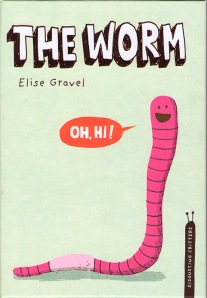
Gravel's The Worm introduces children to the titular invertebrate with a series of interesting facts, accompanied by simple, charming artwork.
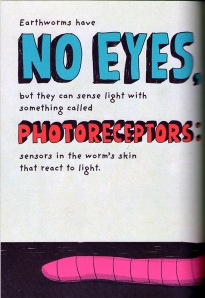
Each two-page spread presents a fact about worms, along with artwork demonstrating--or commenting on--the text. For example, the description of how a worm moves ("Earthworms move by squeezing their muscles, causing their bodies to contract and expand.") is accompanied by a helpful illustration; when the text is less kind to the worm ("An earthworm is basically a long digestive tract inside a muscle tube. It's that muscle tube that's slimy and disgusting."), the worm doesn't take it lying down, so to speak ("Hey! I am not disgusting!").
I enjoyed reading this book. The highlight is certainly the illustrations, but the book's educational content is interesting too, including some facts that even adults may not be familiar with ("many kinds of worms are hermaphrodites, which means they have both male and female reproductive organs").
The Worm, a translation from the French (original title: Le ver), is part of Gravel's Disgusting Creatures series, the other entry in which is The Fly, to be published simultaneously. It's recommended for ages 6-9.
The Worm is on sale March 11, 2014.
I do want to apologize for the quality of the image. I find it very difficult to scan hardcovers, and I didn't want to smash this one enough to get a good scan of a two-page spread, but the single page image doesn't really do it justice.
Other Reading III: The Worm by Elise Gravel (2014, 32 pp.)
Slimy, pink, often seen with dirt or fishing hooks. What is it? The worm, of course! But how well do you really know them? Did you know that some worms can be as much as 115 feet long? Or that worms evolved with the dinosaurs? You'll learn that and more in Elise Gravel's book, The Worm.

Gravel's The Worm introduces children to the titular invertebrate with a series of interesting facts, accompanied by simple, charming artwork.

Each two-page spread presents a fact about worms, along with artwork demonstrating--or commenting on--the text. For example, the description of how a worm moves ("Earthworms move by squeezing their muscles, causing their bodies to contract and expand.") is accompanied by a helpful illustration; when the text is less kind to the worm ("An earthworm is basically a long digestive tract inside a muscle tube. It's that muscle tube that's slimy and disgusting."), the worm doesn't take it lying down, so to speak ("Hey! I am not disgusting!").
I enjoyed reading this book. The highlight is certainly the illustrations, but the book's educational content is interesting too, including some facts that even adults may not be familiar with ("many kinds of worms are hermaphrodites, which means they have both male and female reproductive organs").
The Worm, a translation from the French (original title: Le ver), is part of Gravel's Disgusting Creatures series, the other entry in which is The Fly, to be published simultaneously. It's recommended for ages 6-9.
The Worm is on sale March 11, 2014.
11Sopoforic
And another picture book! I swear, I'll get back to 'real' reading soon.
Other Reading IV: The Sagebrush Singers by Herbert Kernecker (2014, 34 pp.)
This review also appears on my blog.
Four animals, dissatisfied with their lots in life, set out for the town of Big Creek to be musicians. Along the way, they encounter--and drive off--a band of rustlers and horse thieves.
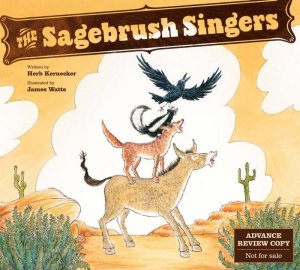
Sound familiar? The Sagebrush Singers, written by Herb Kernecker and illustrated by James Watts, is a very close retelling of "The Bremen Town Musicians", as collected by the Brothers Grimm, set in the American southwest.
In place of the ass, hound, cat, and cock from the original tale, The Sagebrush Singers features a burro, a coyote, a skunk, and a raven. Rather than simply encountering robbers, the Sagebrush Singers encounter a group of rustlers and horse thieves.
That's where the differences end, though; the story and the manner in which it is told are both very close to the source. For example, when the ass and hound come upon the cat, in "The Bremen Town Musicians":
Compare it with the scene in which burro and coyote meet the skunk in The Sagebrush Singers:
The similarity is striking, and it's representative of the story as a whole. That's not to say that it's bad, but it is far from being original. The story is enjoyable enough, but that's because the original story was so.
Where The Sagebrush Singers does deviate from the original is in the motivation of the animals. In "The Bremen Town Musicians", the reasons the animals have fled their homes are an important part of the tone of the story: the ass has grown to old to carry the loads he once could; the dog has grown weak with age and is no longer any use in the hunt; the cat cannot run about after mice, as it did in its younger days; and the cock, though still useful, is to be killed and made into soup for company.
The animals in The Sagebrush Singers have slightly different motivations: the burro has been replaced by a truck, and feels lonely (and hungry) in his corral; the coyote is frustrated by people encroaching on his territory, always out to get him; the skunk has been chased away for become "a little too interested in the chicken coop"; and the raven is unhappy because of pollution.
I feel like the story of "The Bremen Town Musicians" is much stronger for the animals' motivations, and by contrast The Sagebrush Singers is weaker. It's no worse than many children's stories, but I think it's appropriate to compare a retelling to the original, and The Sagebrush Singers doesn't measure up.
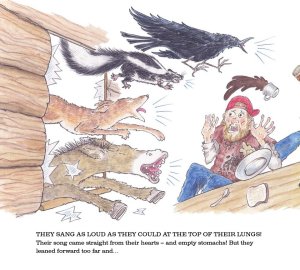
I'm not the biggest fan of the art. It illustrates the scenes well enough, but it doesn't really add to the book. It's just decoration. The style is the sort of simplified and exaggerated line art that is generally used for comedic effect, with uninspiring colors. Looking at some of the artist's other paintings, it seems he favors understated coloration, but his choices here don't suit either the story or the line art very well. It's a shame, because I think a different choice of palette might have provided a lot of atmosphere for the desert setting.
I love folk tales, and I always enjoy seeing retellings of the classics. The Sagebrush Singers is a competent retelling, but it doesn't exceed the original in any way. Those interested in the Brothers Grimm particularly will probably want to take a look at it, but for everyone else, I wouldn't recommend going out of your way for this one.
The Sagebrush Singers goes on sale March 31, 2014. It is recommended for children age 5 and up. It has a website which will feature an audio recording of "The Sagebrush Singers Song", and other supplementary material.
Disclosure: this review is based on an advance copy received free for review.
Other Reading IV: The Sagebrush Singers by Herbert Kernecker (2014, 34 pp.)
This review also appears on my blog.
Four animals, dissatisfied with their lots in life, set out for the town of Big Creek to be musicians. Along the way, they encounter--and drive off--a band of rustlers and horse thieves.

Sound familiar? The Sagebrush Singers, written by Herb Kernecker and illustrated by James Watts, is a very close retelling of "The Bremen Town Musicians", as collected by the Brothers Grimm, set in the American southwest.
In place of the ass, hound, cat, and cock from the original tale, The Sagebrush Singers features a burro, a coyote, a skunk, and a raven. Rather than simply encountering robbers, the Sagebrush Singers encounter a group of rustlers and horse thieves.
That's where the differences end, though; the story and the manner in which it is told are both very close to the source. For example, when the ass and hound come upon the cat, in "The Bremen Town Musicians":
It was not long before they came to a cat sitting in the road, looking as dismal as three wet days.
"Now then, what is the matter with you, old shaver?" said the ass.
Compare it with the scene in which burro and coyote meet the skunk in The Sagebrush Singers:
While crossing a wide arroyo they found little Skunk, lost and squeaking sadly.
"What are you complaining about, old stinker?" Burro asked.
The similarity is striking, and it's representative of the story as a whole. That's not to say that it's bad, but it is far from being original. The story is enjoyable enough, but that's because the original story was so.
Where The Sagebrush Singers does deviate from the original is in the motivation of the animals. In "The Bremen Town Musicians", the reasons the animals have fled their homes are an important part of the tone of the story: the ass has grown to old to carry the loads he once could; the dog has grown weak with age and is no longer any use in the hunt; the cat cannot run about after mice, as it did in its younger days; and the cock, though still useful, is to be killed and made into soup for company.
The animals in The Sagebrush Singers have slightly different motivations: the burro has been replaced by a truck, and feels lonely (and hungry) in his corral; the coyote is frustrated by people encroaching on his territory, always out to get him; the skunk has been chased away for become "a little too interested in the chicken coop"; and the raven is unhappy because of pollution.
I feel like the story of "The Bremen Town Musicians" is much stronger for the animals' motivations, and by contrast The Sagebrush Singers is weaker. It's no worse than many children's stories, but I think it's appropriate to compare a retelling to the original, and The Sagebrush Singers doesn't measure up.

I'm not the biggest fan of the art. It illustrates the scenes well enough, but it doesn't really add to the book. It's just decoration. The style is the sort of simplified and exaggerated line art that is generally used for comedic effect, with uninspiring colors. Looking at some of the artist's other paintings, it seems he favors understated coloration, but his choices here don't suit either the story or the line art very well. It's a shame, because I think a different choice of palette might have provided a lot of atmosphere for the desert setting.
I love folk tales, and I always enjoy seeing retellings of the classics. The Sagebrush Singers is a competent retelling, but it doesn't exceed the original in any way. Those interested in the Brothers Grimm particularly will probably want to take a look at it, but for everyone else, I wouldn't recommend going out of your way for this one.
The Sagebrush Singers goes on sale March 31, 2014. It is recommended for children age 5 and up. It has a website which will feature an audio recording of "The Sagebrush Singers Song", and other supplementary material.
Disclosure: this review is based on an advance copy received free for review.
12PersephonesLibrary
Nice reviews, especially the youngest one. I don't have anything against writers to retell stories, but they have to be original and creative enough to make the new version their own and not just a poor copy...
13Sopoforic
I struggled with that review. On the one hand, I liked it, because it was a retelling of "The Bremen Town Musicians". On the other hand, I only liked it for that reason. In the end, I guess we only owe the books honesty, not generosity, so the review came out pretty negative.
I've got a few other retellings on my reading list (e.g. Ella Enchanted, The Mists of Avalon, The Goose Girl) that I expect to enjoy more, and I've got a giant pile of children's books to go through, so I should have more satisfying examples of those, as well.
I've got a few other retellings on my reading list (e.g. Ella Enchanted, The Mists of Avalon, The Goose Girl) that I expect to enjoy more, and I've got a giant pile of children's books to go through, so I should have more satisfying examples of those, as well.
14Sopoforic
Is a comic book more like real reading? I'm still not counting it toward my 75, though. At this rate, I'll accumulate 75 'other reading' entries far before I complete 75 'real books'. Oh well. I picked this book up on NetGalley. I'd like a paper copy, actually, but my new books budget is right about $0 per month, right now. Maybe once I read the few thousand books I've already got on my shelves...
Other Reading V: Powerpuff Girls Volume 1 by Troy Little (2014, 152 pp.)
This review also appears on my blog.
Sugar, spice, and everything nice: these were the ingredients chosen to create the perfect little girl. But Professor Utonium accidentally added an extra ingredient to the concoction--CHEMICAL X.
Did you read that in the narrator's voice? On November 18, 1998, Blossom, Bubbles, and Buttercup began their weekly crusade against crime, and for the next six years, their adventures graced our TVs. The Powerpuff Girls was a hit, and it spawned at least ten video games, an anime spin-off (2006-2007), and a comic book series by DC (2000-2006). It's been quieter, since, but there was a tenth anniversary special in 2008 and another CGI special in January of this year. It's a series with staying power, and it clearly has a special place in the hearts of its fans.
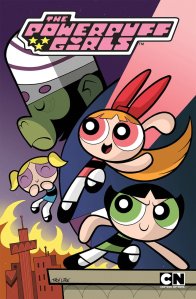
In September 2013, IDW Publishing added another entry in the continuing saga of Powerpuff Girls media: a new comic series, written and drawn by Troy Little, an Eisner nominated writer and artist, and creator of Chiaroscuro and Angora Napkin. The Powerpuff Girls Volume 1 collects the first six issues, forming a complete storyline.
The story opens with Mojo Jojo attacking the city in a giant metal exoskeleton, which he assures the girls is totally unstoppable! As usual, though, they make short work of Mojo's latest attempt, and he's back in prison before he can even finish lamenting his loss.
It seems that this latest failure was the straw that broke the camel's back for Mojo Jojo, and he decides to ask Professor Utonium to administer Antidote X, so he'll no longer be troubled by the memories of his failures. But even with Mojo back to being just Jojo, things aren't normal, since the other villainous residents of Townsville have suddenly and unexpectedly turned over a new leaf, as well. What's happening? Can the girls trust their old enemies, now seemingly allies? Does everyone really deserve a second chance?
This first storyline (as one might expect, for the launch issue) features an ensemble cast of the Powerpuff Girls' most popular adversaries, including Mojo Jojo, Fuzzy Lumpkins, Princess Morbucks, The Ganggreen Gang, and more, with everyone getting a little time in the spotlight. For example, we get to see the Ganggreen Gang taking on an environmental mission (keep Townsville green!), Sedusa working at a hair salon, Fuzzy Lumpkins working as a real estate agent, and Princess Morbucks being positively generous.
The writing is spot-on. The characters' voices are true to their TV counterparts, and the story wouldn't be out of place on the show. It's sprinkled with pop-culture references, which add a bit of flavor to the scenes, and it's got plenty of continuity nods to the cartoon series, for fans. It's nice to see everyone again, after ten years, and this book picks up just as though the show had never ended.
The art, too, is expressive and well-matched with the series. There's a great post on Troy Little's tumblr showing the progress of a page from pencils to finished work. There are some other posts on there with in-progress and completed art, so definitely take a look!
Troy Little's work on this comic is sure to please fans of the series, and it's a solid comic in its own right. The book is available for pre-order now, but it's not going to be released until April 29. It costs about the same as buying the digital issues directly from IDW, though, so for my money, it's worth the wait for a nice collected edition on paper.
Disclosure: this review is based on an advance copy received free for review.
Other Reading V: Powerpuff Girls Volume 1 by Troy Little (2014, 152 pp.)
This review also appears on my blog.
Sugar, spice, and everything nice: these were the ingredients chosen to create the perfect little girl. But Professor Utonium accidentally added an extra ingredient to the concoction--CHEMICAL X.
Did you read that in the narrator's voice? On November 18, 1998, Blossom, Bubbles, and Buttercup began their weekly crusade against crime, and for the next six years, their adventures graced our TVs. The Powerpuff Girls was a hit, and it spawned at least ten video games, an anime spin-off (2006-2007), and a comic book series by DC (2000-2006). It's been quieter, since, but there was a tenth anniversary special in 2008 and another CGI special in January of this year. It's a series with staying power, and it clearly has a special place in the hearts of its fans.

In September 2013, IDW Publishing added another entry in the continuing saga of Powerpuff Girls media: a new comic series, written and drawn by Troy Little, an Eisner nominated writer and artist, and creator of Chiaroscuro and Angora Napkin. The Powerpuff Girls Volume 1 collects the first six issues, forming a complete storyline.
The story opens with Mojo Jojo attacking the city in a giant metal exoskeleton, which he assures the girls is totally unstoppable! As usual, though, they make short work of Mojo's latest attempt, and he's back in prison before he can even finish lamenting his loss.
It seems that this latest failure was the straw that broke the camel's back for Mojo Jojo, and he decides to ask Professor Utonium to administer Antidote X, so he'll no longer be troubled by the memories of his failures. But even with Mojo back to being just Jojo, things aren't normal, since the other villainous residents of Townsville have suddenly and unexpectedly turned over a new leaf, as well. What's happening? Can the girls trust their old enemies, now seemingly allies? Does everyone really deserve a second chance?
This first storyline (as one might expect, for the launch issue) features an ensemble cast of the Powerpuff Girls' most popular adversaries, including Mojo Jojo, Fuzzy Lumpkins, Princess Morbucks, The Ganggreen Gang, and more, with everyone getting a little time in the spotlight. For example, we get to see the Ganggreen Gang taking on an environmental mission (keep Townsville green!), Sedusa working at a hair salon, Fuzzy Lumpkins working as a real estate agent, and Princess Morbucks being positively generous.
The writing is spot-on. The characters' voices are true to their TV counterparts, and the story wouldn't be out of place on the show. It's sprinkled with pop-culture references, which add a bit of flavor to the scenes, and it's got plenty of continuity nods to the cartoon series, for fans. It's nice to see everyone again, after ten years, and this book picks up just as though the show had never ended.
The art, too, is expressive and well-matched with the series. There's a great post on Troy Little's tumblr showing the progress of a page from pencils to finished work. There are some other posts on there with in-progress and completed art, so definitely take a look!
Troy Little's work on this comic is sure to please fans of the series, and it's a solid comic in its own right. The book is available for pre-order now, but it's not going to be released until April 29. It costs about the same as buying the digital issues directly from IDW, though, so for my money, it's worth the wait for a nice collected edition on paper.
Disclosure: this review is based on an advance copy received free for review.
15Sopoforic
I'm not reviewing every children's book I come across, but I read this one, this morning, and I had to write something about it. The more I read as an adult, the more I find incredible children's books that I missed when I was younger.
Other Reading VI: Amazing Grace by Mary Hoffman and Caroline Binch (1991, 24 pp.)
This review also appears on my blog.
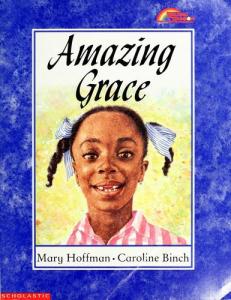
I'll let the book speak for itself:
The story is wonderful and Grace is a kindred spirit to many a reader, each of us a Walter Mitty. She has such personality that one cannot help but become attached to her after only a few pages. When we read that Grace's class is going to put on Peter Pan and that "Grace knew who she wanted to be," we can see the conflict coming--Grace's classmates tell her that she can't play Peter Pan in the class production of the play because Peter is a boy (and besides, Peter Pan isn't black)--but Grace's resoluteness in the face of her classmates' doubts is admirable.
Grace is strong, but she's not invulnerable. When she gets home, her Ma and Nana can see that something is wrong, and they reassure Grace. Then, on Saturday, Nana takes Grace out to see a ballet production of Romeo & Juliet, starring Rosalie Wilkins, "from back home in Trinidad," as Juliet. After this, Grace knows that she can be anything she wants. And when the audition comes for the part of Peter Pan, she proves it--because Grace is amazing.

Binch's watercolor illustrations are excellent. The backgrounds are mostly simple or nonexistent, but it works well, since the focus is on the people, and the artwork portrays them with a great deal of character. The expressions and body language of the characters add substantial depth to their characterization in the text.
The realistic artwork is very well suited to the similarly realistic story. The poses are lifelike, the colors are vivid, and on the whole the art is pleasing to look at. There's a nice balance between complete scenes on one or two whole pages and smaller illustrations.
This is a fantastic book. It was a BCCB Blue Ribbon selection and a Horn Book Fanfare selection in 1991 and was featured on Reading Rainbow in 1993. In 1995, Hoffman published a sequel, Boundless Grace, also illustrated by Binch.
Amazing Grace is recommended for grades 1-3.
Other Reading VI: Amazing Grace by Mary Hoffman and Caroline Binch (1991, 24 pp.)
This review also appears on my blog.

I'll let the book speak for itself:
Grace was a girl who loved stories.
She didn't mind if they were read to her or told to her or made up in her own head. She didn't care if they were in books or movies or out of Nana's long memory. Grace just loved stories.
After she had heard them, and sometimes while they were still going on, Grace would act them out. And she always gave herself the most exciting part.
The story is wonderful and Grace is a kindred spirit to many a reader, each of us a Walter Mitty. She has such personality that one cannot help but become attached to her after only a few pages. When we read that Grace's class is going to put on Peter Pan and that "Grace knew who she wanted to be," we can see the conflict coming--Grace's classmates tell her that she can't play Peter Pan in the class production of the play because Peter is a boy (and besides, Peter Pan isn't black)--but Grace's resoluteness in the face of her classmates' doubts is admirable.
Grace is strong, but she's not invulnerable. When she gets home, her Ma and Nana can see that something is wrong, and they reassure Grace. Then, on Saturday, Nana takes Grace out to see a ballet production of Romeo & Juliet, starring Rosalie Wilkins, "from back home in Trinidad," as Juliet. After this, Grace knows that she can be anything she wants. And when the audition comes for the part of Peter Pan, she proves it--because Grace is amazing.

Binch's watercolor illustrations are excellent. The backgrounds are mostly simple or nonexistent, but it works well, since the focus is on the people, and the artwork portrays them with a great deal of character. The expressions and body language of the characters add substantial depth to their characterization in the text.
The realistic artwork is very well suited to the similarly realistic story. The poses are lifelike, the colors are vivid, and on the whole the art is pleasing to look at. There's a nice balance between complete scenes on one or two whole pages and smaller illustrations.
This is a fantastic book. It was a BCCB Blue Ribbon selection and a Horn Book Fanfare selection in 1991 and was featured on Reading Rainbow in 1993. In 1995, Hoffman published a sequel, Boundless Grace, also illustrated by Binch.
Amazing Grace is recommended for grades 1-3.
16Sopoforic
Here's a picture book which, I'm embarrassed to say, has been sitting on my desk for the last two and a half years. Other books have come and gone, but this and a few of its 'siblings' have been sitting at the bottom of the stack for a long time. I'll be glad when I've gone through each of them so I can shelve them and have some closure.
Other Reading VII: Wise Grandma Duck (1985, 40 pp.)
This review also appears on my blog.
Donald Duck and his nephews, Huey, Dewey, and Louie are headed for Grandma's for vacation. When they arrive, she tells them that her farmhand has gone, and now she has no one to do the chores. The kids enthusiastically offer to help, but Donald is more reticent--farm work was not in his vacation plans! Donald suffers a series of mysterious injuries and ailments, which conveniently clear up just about the time the work is done. Will Donald get away with his laziness?
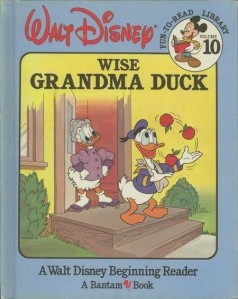
Wise Grandma Duck is the tenth book in the Disney Fun-to-Read Library, and the title pretty much gives away that Donald isn't going to be successful in his trickery. The fun of this book is in seeing the ways his subterfuge is revealed, and how he gets his comeuppance in the end. Like Mickey Meets the Giant, this is a story of the triumph of the clever. Also like Mickey Meets the Giant, this is one of the best books in the Disney Fun-to-Read Library.
Grandma Duck shows her cleverness in little ways throughout the story. When Donald is pretending to have a sore arm, she asks his nephews to throw him an apple. When he, unthinking, catches it with his 'sore' arm, she simply comments that she's glad his arm is better. She might have believed him the first time he claimed to be unable to work, but he didn't keep her in the dark for long.
In the end, Grandma Duck prepares a huge feast for everyone, giving each what he's worked for: corn on the cob for Louie, apple pie for Huey, and pumpkin pie for Dewey--and a tray of medicine for Donald!
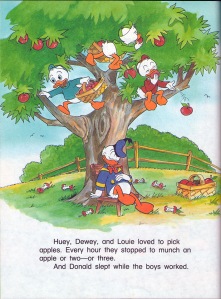
Like the other books in this series, the artwork is high-quality and on-model. It's got a few illustrations that are fairly amusing, but there's nothing really outstanding.
Wise Grandma Duck may not be the best children's literature has to offer, but, as the series promises, it is fun to read.
Other Reading VII: Wise Grandma Duck (1985, 40 pp.)
This review also appears on my blog.
Donald Duck and his nephews, Huey, Dewey, and Louie are headed for Grandma's for vacation. When they arrive, she tells them that her farmhand has gone, and now she has no one to do the chores. The kids enthusiastically offer to help, but Donald is more reticent--farm work was not in his vacation plans! Donald suffers a series of mysterious injuries and ailments, which conveniently clear up just about the time the work is done. Will Donald get away with his laziness?

Wise Grandma Duck is the tenth book in the Disney Fun-to-Read Library, and the title pretty much gives away that Donald isn't going to be successful in his trickery. The fun of this book is in seeing the ways his subterfuge is revealed, and how he gets his comeuppance in the end. Like Mickey Meets the Giant, this is a story of the triumph of the clever. Also like Mickey Meets the Giant, this is one of the best books in the Disney Fun-to-Read Library.
Grandma Duck shows her cleverness in little ways throughout the story. When Donald is pretending to have a sore arm, she asks his nephews to throw him an apple. When he, unthinking, catches it with his 'sore' arm, she simply comments that she's glad his arm is better. She might have believed him the first time he claimed to be unable to work, but he didn't keep her in the dark for long.
In the end, Grandma Duck prepares a huge feast for everyone, giving each what he's worked for: corn on the cob for Louie, apple pie for Huey, and pumpkin pie for Dewey--and a tray of medicine for Donald!

Like the other books in this series, the artwork is high-quality and on-model. It's got a few illustrations that are fairly amusing, but there's nothing really outstanding.
Wise Grandma Duck may not be the best children's literature has to offer, but, as the series promises, it is fun to read.
17Sopoforic
Rather than randomly reading picture books, I thought I should try to make progress on some of my more 'serious' projects, so... I non-randomly read a picture book. I've been meaning to read more Newbery and Caldecott winners, but I never seem to get around to it. I can't say I'm all that happy with my choice, though...
Also, I'm counting this as a 'real' book because 1) Caldecott winner! 2) I'm tired of only having three books read and 3) My thread, my rules.
Book 4: Animals of the Bible: A Picture Book by Dorothy P. Lathrop (1937, 65 pp.)
This review also appears on my blog.
Animals feature prominently in the Bible. Animals of the Bible: A Picture Book collects passages from the King James Bible, selected by Helen Dean Fish, that relate to animals, and pairs them with illustrations by Dorothy P. Lathrop.
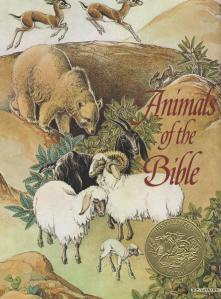
For children's literature, two awards are preeminent: the Newbery Medal, first awarded in 1922, for children's literature; and the Caldecott Medal, first awarded in 1938, for picture books. Each has been awarded to some truly outstanding literature, over the years.
It has also, apparently, been awarded to some less-than-excellent books.
Animals of the Bible is less of a picture book, and more a series of drawings, each with an (extended) epigraph selected from the Bible. One can hardly criticize the quality of a set of Biblical quotations, each at most, perhaps, a dozen verses together, but it can be said that the text certainly forms no story, nor teaches anything in particular, nor has any coherent theme. It's more what I would expect from a Bible-themed calendar than a Caldecott winner.
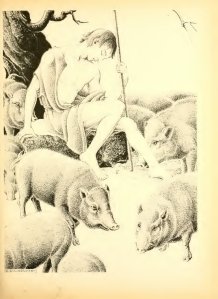
Even the illustrations are something of a mixed bag. The animals are, as the introduction insists, generally relatively lifelike. The humans, though... well, just look at them. The prodigal son, there, looks as flat and oddly-posed as a thirteenth-century Madonna. Worse, really--especially in comparison to the substantially more realistic swine.
I suppose it was overly optimistic of me to assume that this book must be very good, just because it was a Caldecott winner--particularly since it was the first Caldecott winner. It's remained in print, all these years, on strength (I imagine) of that award. But it doesn't measure up to its successors.
Also, I'm counting this as a 'real' book because 1) Caldecott winner! 2) I'm tired of only having three books read and 3) My thread, my rules.
Book 4: Animals of the Bible: A Picture Book by Dorothy P. Lathrop (1937, 65 pp.)
This review also appears on my blog.
Animals feature prominently in the Bible. Animals of the Bible: A Picture Book collects passages from the King James Bible, selected by Helen Dean Fish, that relate to animals, and pairs them with illustrations by Dorothy P. Lathrop.

For children's literature, two awards are preeminent: the Newbery Medal, first awarded in 1922, for children's literature; and the Caldecott Medal, first awarded in 1938, for picture books. Each has been awarded to some truly outstanding literature, over the years.
It has also, apparently, been awarded to some less-than-excellent books.
Animals of the Bible is less of a picture book, and more a series of drawings, each with an (extended) epigraph selected from the Bible. One can hardly criticize the quality of a set of Biblical quotations, each at most, perhaps, a dozen verses together, but it can be said that the text certainly forms no story, nor teaches anything in particular, nor has any coherent theme. It's more what I would expect from a Bible-themed calendar than a Caldecott winner.

Even the illustrations are something of a mixed bag. The animals are, as the introduction insists, generally relatively lifelike. The humans, though... well, just look at them. The prodigal son, there, looks as flat and oddly-posed as a thirteenth-century Madonna. Worse, really--especially in comparison to the substantially more realistic swine.
I suppose it was overly optimistic of me to assume that this book must be very good, just because it was a Caldecott winner--particularly since it was the first Caldecott winner. It's remained in print, all these years, on strength (I imagine) of that award. But it doesn't measure up to its successors.
18Sopoforic
And the wave of picture books continues. Perhaps it's because it's so much easier to write something about picture books than novels.
I've been refraining from adding any books here, until I have written a review, but it'd be better to just list them and review them when I get the chance. Decisions, decisions...
Other Reading VIII: Oh, Were They Ever Happy! by Peter Spier (1978, 38 pp.)
This review also appears on my blog.
The three Noonan children, mistakenly left at home without a babysitter, decide to spend their day helping out by painting the house. Oh, won't their parents be happy!
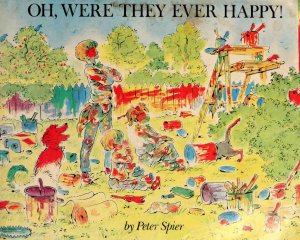
Peter Spier's Oh, Were They Ever Happy! follows the children from beginning ("I do not know who thought of it first, but there was plenty of paint in the garage.") to end ("Sure looks swell! Won't they be happy when they come home and see what we've done!"). As the children go along, they gradually become messier and the house gradually becomes more colorful, as the children use as many colors of paint as it takes to finish the job.
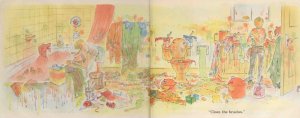
The children even clean up, when they're done! Won't their parents be happy!
This is a very fun book. They story's amusing as the children go along, happily 'helping' by painting their house (windows and all!). With each passing page, it hardly seems that the mess could get any bigger, but turn the page and it's messier still. The art is simple, colorful (and how!), and perfectly pleasant. Altogether, this book rather reminds me of Wacky Wednesday.
Spier won the Caldecott medal in 1978 for Noah's Ark, which is (mostly) wordless, but has a similar style of art.
Strangely, Oh, Were They Ever Happy! seems not to be in print, and the prices at Amazon are higher than expected, but if you do come by a copy, it's surely worth a read.
I've been refraining from adding any books here, until I have written a review, but it'd be better to just list them and review them when I get the chance. Decisions, decisions...
Other Reading VIII: Oh, Were They Ever Happy! by Peter Spier (1978, 38 pp.)
This review also appears on my blog.
The three Noonan children, mistakenly left at home without a babysitter, decide to spend their day helping out by painting the house. Oh, won't their parents be happy!

Peter Spier's Oh, Were They Ever Happy! follows the children from beginning ("I do not know who thought of it first, but there was plenty of paint in the garage.") to end ("Sure looks swell! Won't they be happy when they come home and see what we've done!"). As the children go along, they gradually become messier and the house gradually becomes more colorful, as the children use as many colors of paint as it takes to finish the job.

The children even clean up, when they're done! Won't their parents be happy!
This is a very fun book. They story's amusing as the children go along, happily 'helping' by painting their house (windows and all!). With each passing page, it hardly seems that the mess could get any bigger, but turn the page and it's messier still. The art is simple, colorful (and how!), and perfectly pleasant. Altogether, this book rather reminds me of Wacky Wednesday.
Spier won the Caldecott medal in 1978 for Noah's Ark, which is (mostly) wordless, but has a similar style of art.
Strangely, Oh, Were They Ever Happy! seems not to be in print, and the prices at Amazon are higher than expected, but if you do come by a copy, it's surely worth a read.
20Sopoforic
Here are a few more picture books that I've read recently, but not written out whole reviews. I'll be happy to talk more about any of them in greater detail (and I probably will, eventually), if someone is interested. But, in short:
Other Reading IX: The Girl Who Loved Wild Horses by Paul Goble (1978)
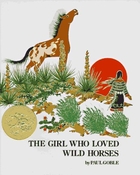
Winner of the 1979 Caldecott Medal. I like the art in this; it's got a pretty unique style. Oddly enough, it reminds me of the art in Meena. The story is okay, but I'd say the art is definitely its strong point.
Other Reading X: The Relatives Came by Cynthia Rylant (1985)

A 1986 Caldecott honor book. Cute story. It's got no conflict, just a mellow (but amusing) story of relatives from Virginia coming to visit. The art is rendered in colored pencil by Stephen Gammell, whose work I'm more familiar with from Scary Stories to Tell in the Dark. The people share the characteristic 'lumpiness' of the illustrations from that book, but there's nothing horrifying about these. Just lighthearted art in a palette heavy in greens and blues.
Other Reading XI: Boundless Grace by Mary Hoffman and Caroline Binch (1995)

This is the sequel to Amazing Grace, which I reviewed above (and enjoyed immensely!). I don't think it's quite the equal of its predecessor, but it's still a strong book, telling a story about Grace's relationship with her father, who has long since divorced her mother and lives in Africa.
Other Reading XII: Ira Sleeps Over by Bernard Waber (1972)

Nice enough story. Ira's invited to sleep over at his friend Reggie's house, but is afraid he'll be laughed at for sleeping with a teddy bear. It turns out that Reggie sleeps with a teddy bear--and was worried--too. The art is fitting and interesting.
Other Reading XIII: Rosie's Walk by Pat Hutchins (1968)

A great use of medium. The text is a single sentence, describing Rosie the hen's peaceful walk around the farm ("Rosie the hen went for a walk . . . and got back in time for dinner."), but the illustrations tell a different story: the whole time, a fox is pursuing her, intent on getting his own dinner. Humorous mishaps keep stopping him, and eventually he's chased off by a swarm of bees. The art is nice--red, orange, and yellow in the foreground and green in the background, usually with heavy borders, giving everything a sort of paper cutout look. Quite enjoyable.
Other Reading XIV: Hey, Al by Arthur Yorinks and Richard Egielski (1986)

Winner of the 1987 Caldecott Medal. Al and his dog, Eddie, live in a tiny one-room apartment, and Eddie isn't happy. They're led by a large bird to a kind of paradise, but they begin to turn into birds themselves, so they escape and are happy with their old apartment. "Paradise lost is sometimes Heaven found."
The art is cleverly fit into rectangles, with bits poking out at the edges. Extremely nice. There's good emotional impact when Al believes he's lost Eddie, too. An altogether very good book.
Other Reading XV: How My Parents Learned to Eat by Ina R. Friedman and Allen Say (1984)

I first read this years ago, in school. It's a story of clashing cultures: an American sailor and a Japanese schoolgirl fall in love, and fear to eat with the other, not knowing how to use chopsticks (resp. a fork). This book isn't bad, but I think most of my enjoyment was from nostalgia. The art is nice, but pretty flat, and the story boils down to "different cultures have different customs, but we shouldn't be afraid to learn from each other". Nothing really wrong with it, but this isn't a book I'd want to re-read often.
Other Reading IX: The Girl Who Loved Wild Horses by Paul Goble (1978)

Winner of the 1979 Caldecott Medal. I like the art in this; it's got a pretty unique style. Oddly enough, it reminds me of the art in Meena. The story is okay, but I'd say the art is definitely its strong point.
Other Reading X: The Relatives Came by Cynthia Rylant (1985)

A 1986 Caldecott honor book. Cute story. It's got no conflict, just a mellow (but amusing) story of relatives from Virginia coming to visit. The art is rendered in colored pencil by Stephen Gammell, whose work I'm more familiar with from Scary Stories to Tell in the Dark. The people share the characteristic 'lumpiness' of the illustrations from that book, but there's nothing horrifying about these. Just lighthearted art in a palette heavy in greens and blues.
Other Reading XI: Boundless Grace by Mary Hoffman and Caroline Binch (1995)

This is the sequel to Amazing Grace, which I reviewed above (and enjoyed immensely!). I don't think it's quite the equal of its predecessor, but it's still a strong book, telling a story about Grace's relationship with her father, who has long since divorced her mother and lives in Africa.
Other Reading XII: Ira Sleeps Over by Bernard Waber (1972)

Nice enough story. Ira's invited to sleep over at his friend Reggie's house, but is afraid he'll be laughed at for sleeping with a teddy bear. It turns out that Reggie sleeps with a teddy bear--and was worried--too. The art is fitting and interesting.
Other Reading XIII: Rosie's Walk by Pat Hutchins (1968)

A great use of medium. The text is a single sentence, describing Rosie the hen's peaceful walk around the farm ("Rosie the hen went for a walk . . . and got back in time for dinner."), but the illustrations tell a different story: the whole time, a fox is pursuing her, intent on getting his own dinner. Humorous mishaps keep stopping him, and eventually he's chased off by a swarm of bees. The art is nice--red, orange, and yellow in the foreground and green in the background, usually with heavy borders, giving everything a sort of paper cutout look. Quite enjoyable.
Other Reading XIV: Hey, Al by Arthur Yorinks and Richard Egielski (1986)

Winner of the 1987 Caldecott Medal. Al and his dog, Eddie, live in a tiny one-room apartment, and Eddie isn't happy. They're led by a large bird to a kind of paradise, but they begin to turn into birds themselves, so they escape and are happy with their old apartment. "Paradise lost is sometimes Heaven found."
The art is cleverly fit into rectangles, with bits poking out at the edges. Extremely nice. There's good emotional impact when Al believes he's lost Eddie, too. An altogether very good book.
Other Reading XV: How My Parents Learned to Eat by Ina R. Friedman and Allen Say (1984)

I first read this years ago, in school. It's a story of clashing cultures: an American sailor and a Japanese schoolgirl fall in love, and fear to eat with the other, not knowing how to use chopsticks (resp. a fork). This book isn't bad, but I think most of my enjoyment was from nostalgia. The art is nice, but pretty flat, and the story boils down to "different cultures have different customs, but we shouldn't be afraid to learn from each other". Nothing really wrong with it, but this isn't a book I'd want to re-read often.
21Sopoforic
Other Reading XVI: Welcome Back, Snow White (1986, 48 pp.)
This review also appears on my blog.
One day, the Seven Dwarfs receive a letter from the castle. It's from Snow White, letting them know that she'll be visiting. The dwarfs are very excited to see her, but their house is a mess! Will they be able to clean up in time for Snow White's visit?
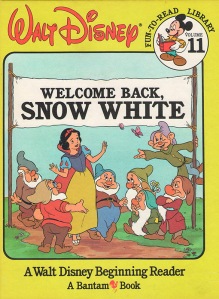
The eleventh book in the Disney Fun-to-Read Library, Welcome Back, Snow White is about working together to accomplish something too difficult to do alone. When the dwarfs attempt to clean the house individually, they cause a bigger mess than they started with. But when they coordinate their efforts, they're able to get the job done and impress Snow White with their cooperation.
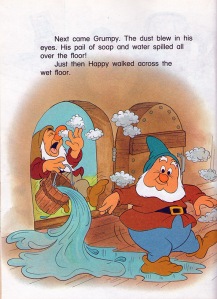
The art, as usual for these, is nice enough. It looks very like the film transferred to the page. Of course, what made Snow White and the Seven Dwarfs a great work of animation was the realistic, fluid quality of the movement--it's not enough for a book to copy its character designs. This book, like the others in this series, has high-quality art and decent writing, but it isn't a strong example of a picture book. For a picture book to be great, the art and text need to work together to form a greater whole. The art in Welcome Back, Snow White perfectly illustrates the scenes, but it doesn't do anything more than that. Of course, this is the quibble of an adult fan of literature--I don't think I had any complaints about these, twenty years ago.
This review also appears on my blog.
One day, the Seven Dwarfs receive a letter from the castle. It's from Snow White, letting them know that she'll be visiting. The dwarfs are very excited to see her, but their house is a mess! Will they be able to clean up in time for Snow White's visit?

The eleventh book in the Disney Fun-to-Read Library, Welcome Back, Snow White is about working together to accomplish something too difficult to do alone. When the dwarfs attempt to clean the house individually, they cause a bigger mess than they started with. But when they coordinate their efforts, they're able to get the job done and impress Snow White with their cooperation.

The art, as usual for these, is nice enough. It looks very like the film transferred to the page. Of course, what made Snow White and the Seven Dwarfs a great work of animation was the realistic, fluid quality of the movement--it's not enough for a book to copy its character designs. This book, like the others in this series, has high-quality art and decent writing, but it isn't a strong example of a picture book. For a picture book to be great, the art and text need to work together to form a greater whole. The art in Welcome Back, Snow White perfectly illustrates the scenes, but it doesn't do anything more than that. Of course, this is the quibble of an adult fan of literature--I don't think I had any complaints about these, twenty years ago.
22Sopoforic
Other Reading XVII: The Bully Goat Grim by Willy Claflin and James Stimson (2012, 39 pp.)
This review also appears on my blog.
A family of trolls, having a lie-in after a late-night rude noises contest, is awakened by a huge billy goat with a bad case of Random Hostility Syndrome. It stomps across their bridge, shouting "Beware, beware, the Bully Goat Grim! Nobody better not mess with him!" However will they get back to their peaceful existence?
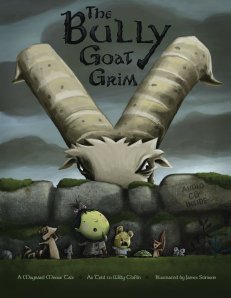
The Bully Goat Grim, written by Willy Claflin and illustrated by James Stimson, is a "Mother Moose Tale" loosely inspired by the story of the Three Billy Goats Gruff. In Claflin's version, it's the trolls living under the bridge who are the heroes, and the huge, mean goat who is the villain.
This goat, called Bully Goat Grim, is in the habit of finding unsuspecting woodland creatures, lowering his oversized head, and charging them. Soon enough, all the creatures around are in bandages and slings, hiding from Bully Goat Grim, so he takes out a map and heads for greener pastures.
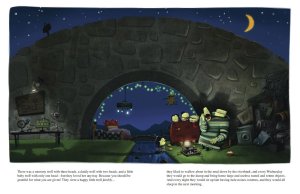
On the way to said greener pastures is a bridge, under which lives a family of trolls: the mother with three heads, the father with two, and the daughter with only one. Bully Goat Grim makes a nuisance of himself, waking the family. The father gets into an argument with himself over how to deal with the situation, and ends up knocking himself out, and the mother discusses with herself until all three heads fall asleep, so it's up to the baby troll to solve their problem.
The baby troll realizes (being very clever for such a young troll) that "Nobody better not mess with him!" is a double negative, which means that she should mess with Bully Goat Grim. So she finds a pillow and constructs herself a parachute, then taunts the goat into charging her. When he does--poof!--the pillow absorbs the blow and the baby troll gets a free air ride.
Before long, all the animals in the forest have adopted the baby troll's idea.
The artwork in this book is very appealing. Not only are the illustrations funny, most are filled with interesting little details. When discussing what to do about the goat, for instance, the mother troll is eating Odin brand tyttebær syltetøy--Norwegian for lingonberry jam. Very appropriate, since the story of the Three Billy Goats Gruff is originally Norwegian!
The writing is unusual, but funny. It's got a lot of fake words (like 'distremely', above) sprinkled in, which the book explains is from the original story, told in the Moose language--the book's conceit is that Claflin is merely translating the stories told to him by Maynard Moose--and the grammar is nonstandard. If the story is performed, rather than merely read, these will work well, but they're a little distracting, when reading.
Willy Claflin is not only an author, but a singer and storyteller as well. With the aid of a number of hand puppets, he has performed full-time since 1983. For a sample, you can see him perform at the UMSL St. Louis Storytelling Festival 2012. The book comes with an audio CD recording of the story, though my review copy did not include this.
Disclosure: this review is based on an advance copy received free for review.
This review also appears on my blog.
A family of trolls, having a lie-in after a late-night rude noises contest, is awakened by a huge billy goat with a bad case of Random Hostility Syndrome. It stomps across their bridge, shouting "Beware, beware, the Bully Goat Grim! Nobody better not mess with him!" However will they get back to their peaceful existence?

The Bully Goat Grim, written by Willy Claflin and illustrated by James Stimson, is a "Mother Moose Tale" loosely inspired by the story of the Three Billy Goats Gruff. In Claflin's version, it's the trolls living under the bridge who are the heroes, and the huge, mean goat who is the villain.
This goat, called Bully Goat Grim, is in the habit of finding unsuspecting woodland creatures, lowering his oversized head, and charging them. Soon enough, all the creatures around are in bandages and slings, hiding from Bully Goat Grim, so he takes out a map and heads for greener pastures.

On the way to said greener pastures is a bridge, under which lives a family of trolls: the mother with three heads, the father with two, and the daughter with only one. Bully Goat Grim makes a nuisance of himself, waking the family. The father gets into an argument with himself over how to deal with the situation, and ends up knocking himself out, and the mother discusses with herself until all three heads fall asleep, so it's up to the baby troll to solve their problem.
The baby troll realizes (being very clever for such a young troll) that "Nobody better not mess with him!" is a double negative, which means that she should mess with Bully Goat Grim. So she finds a pillow and constructs herself a parachute, then taunts the goat into charging her. When he does--poof!--the pillow absorbs the blow and the baby troll gets a free air ride.
Before long, all the animals in the forest have adopted the baby troll's idea.
Now there is nothing worse than having Random Hostility Syndrome and not being able to injure anybody. It was distremely depressing to the Bully Goat Grim, and so finally he just give up and slunk away. He slunk, and slunk, and slunk, until he was completely away.
The artwork in this book is very appealing. Not only are the illustrations funny, most are filled with interesting little details. When discussing what to do about the goat, for instance, the mother troll is eating Odin brand tyttebær syltetøy--Norwegian for lingonberry jam. Very appropriate, since the story of the Three Billy Goats Gruff is originally Norwegian!
The writing is unusual, but funny. It's got a lot of fake words (like 'distremely', above) sprinkled in, which the book explains is from the original story, told in the Moose language--the book's conceit is that Claflin is merely translating the stories told to him by Maynard Moose--and the grammar is nonstandard. If the story is performed, rather than merely read, these will work well, but they're a little distracting, when reading.
Willy Claflin is not only an author, but a singer and storyteller as well. With the aid of a number of hand puppets, he has performed full-time since 1983. For a sample, you can see him perform at the UMSL St. Louis Storytelling Festival 2012. The book comes with an audio CD recording of the story, though my review copy did not include this.
Disclosure: this review is based on an advance copy received free for review.
23Sopoforic
Other Reading XVIII: Mei Li by Thomas Handforth (1938, 44 pp.)
This review also appears on my blog.
Mei Li wishes to go to the New Year Fair in the city, but little girls always have to stay home. Undaunted, she sneaks out to visit the city, following her brother. What adventures await?
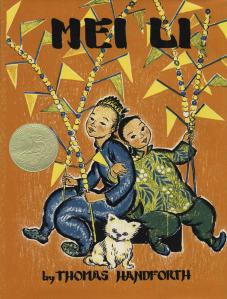
Thomas Handforth's Mei Li is the winner of the 1939 Caldecott Medal. Unlike the previous winner, Animals of the Bible, Mei Li is a real picture book.
The story centers around a young Chinese girl, Mei Li, who is unsatisfied with remaining at home, while the New Year Fair is going on. "If I always stay at home," she asks, "what can I be good for?" So off she goes to have adventures like her brother, San Yu. He wonders what a girl could do at the fair, but she bribes him to take her with him, all the same.
The fair is as exciting as Mei Li had hoped, and she shows her doubting brother all the things that a girl can do, at the fair. Looking at a group of circus performers, she tells him, "They can walk on stilts. They can balance on a tight-rope. They can throw pots and pans in the air with their feet. And so can I!"
Mei Li doesn't juggle pots and pans with her feet, but she does ask a strong circus girl to lift her upside-down in the palm of her hand; she feeds a bear a bit of bean-cake; and she dances on the back of a circus pony. Later, a fortune teller predicts that Mei Li will rule over a kingdom--naturally, she believes him. Soon after, they must hurry home, so they will be in time to greet the Kitchen God.
When she returns home, Mei Li's mother refers to her as "the princess who rules our hears." She is surely a princess, but what sort of kingdom will she rule over? That night, the Kitchen God explains:
Mei Li is based on Handforth's experiences while living in China for six years, beginning in 1931, the characters and drawings are based on people he knew, and the titular heroine is based on Pu Mei Li, a four-year-old girl he met there. Much more information about this, including a photograph of the real Mei Li holding Handforth's picture book, can be found in this article from The Horn Book Magazine by Kathleen Horning (who, coincidentally, wrote From Cover to Cover: Evaluating and Reviewing Children's Books, which I read almost exactly two years ago).
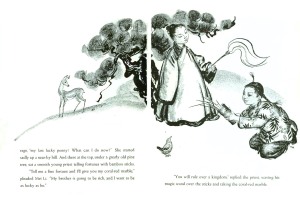
The illustrations are in ink, done with a brush, which Handforth felt better captured the spirit of China. Few of the illustrations feature any background, but the figures represented are generally very dynamic. The book does feature a number of two-page spreads, varying text positioning depending on the artwork. The illustrations depict the actual scenes in the book, making Mei Li much more of a 'real' picture book than its predecessor for the Caldecott Medal.
Mei Li has been criticized for sexism. Not without grounds: Mei Li is told that her 'kingdom' is the home, and the book ends with a poem extolling the virtues of a woman who keeps a good house:
Furthermore, Mei Li is shown to be frightened of fireworks, allowing San Yu to set them off while she plugs her ears, and she gives her last lucky penny to San Yu to throw at a bell (for the promise of money all year), since she is sure that she could never hit it.
I think these criticisms are a little misguided; at least, they don't look at the whole picture. Compare what Mei Li does at the fair to what San Yu does: while Mei Li balances upside down on a circus performer's hand, San Yu dresses up as a wise man for a play; while Mei Li feeds a real bear a cake, to show her bravery, San Yu pretends to hunt a lion that is really two boys with a mask; Mei Li dances on the back of a prancing horse, after which San Yu throws her penny at a bell and goes off to buy a kite (a fake hawk, which he later uses to frighten Mei Li). Mei Li's adventures at the fair are real, and San Yu's are merely imaginary. Certainly it is Mei Li who comes off best in their little competition!
Too, Mei Li gives her first lucky penny to a beggar girl she meets when entering the city, and it's that girl who holds the gates open so that she can leave the city and return home to greet the Kitchen God, "And even five policemen and five soldiers could not force her away until Mei Li was through the gate." Not so easily cowed, this girl!
Finally, though the statement of the Kitchen God that the house is Mei Li's kingdom may be reinforcing the domestic role of women, Mei Li responds that it will do "for a while, anyway", which also means that eventually, it won't be enough. And Handforth wrote, of the real Mei Li:
Certainly some older children's books do not stand the test of time, as cultural values march on (The Five Chinese Brothers or Shen of the Sea, both coincidentally also dealing with China, are examples of this, for different reasons), but I wouldn't fear to recommend Mei Li.
Relatively little is to be found online about this book or its author. There is some other material from The Horn Book Magazine, linked above, including the magazine's contemporary review of the book, written by Elizabeth Coatsworth, originally published in the July-August 1939 issue. The Art Institute of Chicago, The Smithsonian American Art Museum, and The Seattle Public Library Northwest Art Collection each provide a few samples of Handforth's other art, including one picture which must (I think) have been the original model for a scene from Mei Li.
Altogether, I find Mei Li to be a much worthier recipient of the Caldecott Medal than its predecessor, and a good book, besides. I hope that the later recipients continue more in this vein!
This review also appears on my blog.
Mei Li wishes to go to the New Year Fair in the city, but little girls always have to stay home. Undaunted, she sneaks out to visit the city, following her brother. What adventures await?

Thomas Handforth's Mei Li is the winner of the 1939 Caldecott Medal. Unlike the previous winner, Animals of the Bible, Mei Li is a real picture book.
The story centers around a young Chinese girl, Mei Li, who is unsatisfied with remaining at home, while the New Year Fair is going on. "If I always stay at home," she asks, "what can I be good for?" So off she goes to have adventures like her brother, San Yu. He wonders what a girl could do at the fair, but she bribes him to take her with him, all the same.
The fair is as exciting as Mei Li had hoped, and she shows her doubting brother all the things that a girl can do, at the fair. Looking at a group of circus performers, she tells him, "They can walk on stilts. They can balance on a tight-rope. They can throw pots and pans in the air with their feet. And so can I!"
Mei Li doesn't juggle pots and pans with her feet, but she does ask a strong circus girl to lift her upside-down in the palm of her hand; she feeds a bear a bit of bean-cake; and she dances on the back of a circus pony. Later, a fortune teller predicts that Mei Li will rule over a kingdom--naturally, she believes him. Soon after, they must hurry home, so they will be in time to greet the Kitchen God.
When she returns home, Mei Li's mother refers to her as "the princess who rules our hears." She is surely a princess, but what sort of kingdom will she rule over? That night, the Kitchen God explains:
"This house is your kingdom and palace. Within its walls all living things are your loyal, loving subjects."
Mei Li sighed happily, "It will do for a while, anyway."
Mei Li is based on Handforth's experiences while living in China for six years, beginning in 1931, the characters and drawings are based on people he knew, and the titular heroine is based on Pu Mei Li, a four-year-old girl he met there. Much more information about this, including a photograph of the real Mei Li holding Handforth's picture book, can be found in this article from The Horn Book Magazine by Kathleen Horning (who, coincidentally, wrote From Cover to Cover: Evaluating and Reviewing Children's Books, which I read almost exactly two years ago).

The illustrations are in ink, done with a brush, which Handforth felt better captured the spirit of China. Few of the illustrations feature any background, but the figures represented are generally very dynamic. The book does feature a number of two-page spreads, varying text positioning depending on the artwork. The illustrations depict the actual scenes in the book, making Mei Li much more of a 'real' picture book than its predecessor for the Caldecott Medal.
Mei Li has been criticized for sexism. Not without grounds: Mei Li is told that her 'kingdom' is the home, and the book ends with a poem extolling the virtues of a woman who keeps a good house:
This is the thrifty princess,
Whose house is always clean,
No dirt within her kingdom
Is ever to be seen.
Her food is fit
For a king to eat,
Her hair and clothes
Are always neat.
Furthermore, Mei Li is shown to be frightened of fireworks, allowing San Yu to set them off while she plugs her ears, and she gives her last lucky penny to San Yu to throw at a bell (for the promise of money all year), since she is sure that she could never hit it.
I think these criticisms are a little misguided; at least, they don't look at the whole picture. Compare what Mei Li does at the fair to what San Yu does: while Mei Li balances upside down on a circus performer's hand, San Yu dresses up as a wise man for a play; while Mei Li feeds a real bear a cake, to show her bravery, San Yu pretends to hunt a lion that is really two boys with a mask; Mei Li dances on the back of a prancing horse, after which San Yu throws her penny at a bell and goes off to buy a kite (a fake hawk, which he later uses to frighten Mei Li). Mei Li's adventures at the fair are real, and San Yu's are merely imaginary. Certainly it is Mei Li who comes off best in their little competition!
Too, Mei Li gives her first lucky penny to a beggar girl she meets when entering the city, and it's that girl who holds the gates open so that she can leave the city and return home to greet the Kitchen God, "And even five policemen and five soldiers could not force her away until Mei Li was through the gate." Not so easily cowed, this girl!
Finally, though the statement of the Kitchen God that the house is Mei Li's kingdom may be reinforcing the domestic role of women, Mei Li responds that it will do "for a while, anyway", which also means that eventually, it won't be enough. And Handforth wrote, of the real Mei Li:
No Empress Dowager was ever more determined than she. A career is surely ordained for her, other than being the heroine of a children’s book.
Certainly some older children's books do not stand the test of time, as cultural values march on (The Five Chinese Brothers or Shen of the Sea, both coincidentally also dealing with China, are examples of this, for different reasons), but I wouldn't fear to recommend Mei Li.
Relatively little is to be found online about this book or its author. There is some other material from The Horn Book Magazine, linked above, including the magazine's contemporary review of the book, written by Elizabeth Coatsworth, originally published in the July-August 1939 issue. The Art Institute of Chicago, The Smithsonian American Art Museum, and The Seattle Public Library Northwest Art Collection each provide a few samples of Handforth's other art, including one picture which must (I think) have been the original model for a scene from Mei Li.
Altogether, I find Mei Li to be a much worthier recipient of the Caldecott Medal than its predecessor, and a good book, besides. I hope that the later recipients continue more in this vein!
24Sopoforic
Another comic. I enjoy retellings, but this one just wasn't that great, I fear.
Other Reading XIX: Grimm Fairy Tales: Oz by Joe Brusha et al. (2014, 153 pp.)
This review also appears (with more sample images) on my blog.
The evil daughters of Zamora, intent on conquering the world, seek the Viridian Scepter, a powerful magical artifact which was used to destroy their mother. It has been broken into three pieces, and its handle stolen, taken by a ghost wolf to another world, the nexus. There, it is found by a girl who can, mysteriously, wield it, although it should be possible only for the most powerful of Highborns.
Does this story sound familiar to you? Let me describe it again.
Young Dorothy Gale, who lives on a farm in Kansas, finds a wolf, which she names Toto, and determines to keep it as a pet. Soon after, her house is lifted by a tornado and Dorothy finds herself in the land of Oz, where the Wicked Witches of the East and West terrorize the land. Dorothy accidentally kills the Wicked Witch of the East using a rod that Toto carried, which is sure to cause the witch's sister to target her. So Dorothy sets out on a journey across Oz to complete the scepter, of which Toto's rod was a part, and use it to destroy the Wicked Witch of the West and return home.
That's probably more recognizable, isn't it?
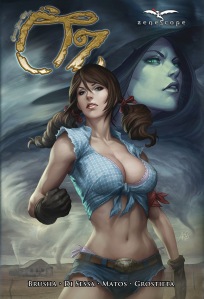
Grimm Fairy Tales presents Oz is a hardcover collection of the six issue miniseries of the same name from Zenescope Entertainment. The series ran from July 2013 to February 2014, and was written by Joe Brusha, with pencils by Rolando di Sessa, inks by Glauber Matos, and colors by Ulises Grostieta.
The Grimm Fairy Tales series presents re-imaginings of fairy tales, set in a crossover-friendly universe consisting of Earth (called the nexus) and four other worlds: Myst, Neverland, Wonderland, and Oz. The miniseries in this book, as the title implies, is concerned only with the final of these. I've never read any other entries in the Grimm Fairly Tales series, so I can confidently say that this book works as a standalone story.
The story is, in broad stokes, the one we're all familiar with. Dorothy from Earth shows up in Oz, meets some traveling companions, and eventually defeats the wicked witches, freeing Oz from their tyranny. At last, Dorothy goes home. All of the details, though, have been changed.
Rather than setting out alone, Dorothy begins her quest in an RPG-approved cliche party consisting of a magic user (Glinda, the Good Witch of the North), a warrior (Thorne, a member of the lion-like Kavari tribe), and three short comic-relief types (Sparky, Crumb, and Crank, who are Boggers--don't call them munchkins!).
Unfortunately, cliche is rather the name of the game, for this story. Dorothy is mysteriously very powerful. Glinda, the knowledgeable, powerful, and very useful leader of the party (at the outset), ends up conveniently unconscious for the latter part of the story. The third chapter's opening is narrated by a positively painful letter home from Dorothy, in the venerable writing-that-everything-is-fine-while-actually-in-a-pitched-battle style. And the ending is rather spectacularly unsatisfying.
The adaptation isn't without its clever bits, and in particular it does a reasonably good job with the lion, scarecrow, and tin woodsman, but overall the writing is just not up to par.
The artwork is fairly good, but quite variable. Dorothy, in particular, never seems to have quite the same face from panel to panel.
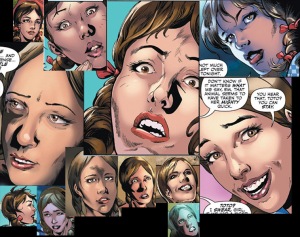
The many faces of Dorothy, from the first two chapters.
I've seen some complaints about the sexualized outfits and poses of the female cast of this book, and I gather that it's something of a staple of the series. The characters certainly wear impractical clothing, and the artist is clearly not above taking advantage of this.
This is certainly not a problem that's limited to this book--it's a common (and valid) criticism of comics in general. That said, I don't think that it's the biggest problem the book has, nor a particularly egregious example of it. The worst of it is all in the alternate covers, but that's not an issue, here.
Grimm Fairy Tales presents Oz is not by any means an excellent comic, but it's not a terrible one, either. It's worth the 45 minutes or so it takes to read, if only that.
Grimm Fairy Tales presents Oz is available in hardcover starting today, March 18, 2014.
Other Reading XIX: Grimm Fairy Tales: Oz by Joe Brusha et al. (2014, 153 pp.)
This review also appears (with more sample images) on my blog.
The evil daughters of Zamora, intent on conquering the world, seek the Viridian Scepter, a powerful magical artifact which was used to destroy their mother. It has been broken into three pieces, and its handle stolen, taken by a ghost wolf to another world, the nexus. There, it is found by a girl who can, mysteriously, wield it, although it should be possible only for the most powerful of Highborns.
Does this story sound familiar to you? Let me describe it again.
Young Dorothy Gale, who lives on a farm in Kansas, finds a wolf, which she names Toto, and determines to keep it as a pet. Soon after, her house is lifted by a tornado and Dorothy finds herself in the land of Oz, where the Wicked Witches of the East and West terrorize the land. Dorothy accidentally kills the Wicked Witch of the East using a rod that Toto carried, which is sure to cause the witch's sister to target her. So Dorothy sets out on a journey across Oz to complete the scepter, of which Toto's rod was a part, and use it to destroy the Wicked Witch of the West and return home.
That's probably more recognizable, isn't it?

Grimm Fairy Tales presents Oz is a hardcover collection of the six issue miniseries of the same name from Zenescope Entertainment. The series ran from July 2013 to February 2014, and was written by Joe Brusha, with pencils by Rolando di Sessa, inks by Glauber Matos, and colors by Ulises Grostieta.
The Grimm Fairy Tales series presents re-imaginings of fairy tales, set in a crossover-friendly universe consisting of Earth (called the nexus) and four other worlds: Myst, Neverland, Wonderland, and Oz. The miniseries in this book, as the title implies, is concerned only with the final of these. I've never read any other entries in the Grimm Fairly Tales series, so I can confidently say that this book works as a standalone story.
The story is, in broad stokes, the one we're all familiar with. Dorothy from Earth shows up in Oz, meets some traveling companions, and eventually defeats the wicked witches, freeing Oz from their tyranny. At last, Dorothy goes home. All of the details, though, have been changed.
Rather than setting out alone, Dorothy begins her quest in an RPG-approved cliche party consisting of a magic user (Glinda, the Good Witch of the North), a warrior (Thorne, a member of the lion-like Kavari tribe), and three short comic-relief types (Sparky, Crumb, and Crank, who are Boggers--don't call them munchkins!).
Unfortunately, cliche is rather the name of the game, for this story. Dorothy is mysteriously very powerful. Glinda, the knowledgeable, powerful, and very useful leader of the party (at the outset), ends up conveniently unconscious for the latter part of the story. The third chapter's opening is narrated by a positively painful letter home from Dorothy, in the venerable writing-that-everything-is-fine-while-actually-in-a-pitched-battle style. And the ending is rather spectacularly unsatisfying.
The adaptation isn't without its clever bits, and in particular it does a reasonably good job with the lion, scarecrow, and tin woodsman, but overall the writing is just not up to par.
The artwork is fairly good, but quite variable. Dorothy, in particular, never seems to have quite the same face from panel to panel.

The many faces of Dorothy, from the first two chapters.
I've seen some complaints about the sexualized outfits and poses of the female cast of this book, and I gather that it's something of a staple of the series. The characters certainly wear impractical clothing, and the artist is clearly not above taking advantage of this.
This is certainly not a problem that's limited to this book--it's a common (and valid) criticism of comics in general. That said, I don't think that it's the biggest problem the book has, nor a particularly egregious example of it. The worst of it is all in the alternate covers, but that's not an issue, here.
Grimm Fairy Tales presents Oz is not by any means an excellent comic, but it's not a terrible one, either. It's worth the 45 minutes or so it takes to read, if only that.
Grimm Fairy Tales presents Oz is available in hardcover starting today, March 18, 2014.
25PersephonesLibrary
Dorothy in Daisy-Dukes? That's a mental picture I have to get rid off... But seriously, nothing against retellings in general, sometimes I only wonder if you really have to publish your own version... Does the changes of Dorothy's face continue or is that only in the first two chapters?
I'm always looking for great new comics and graphic novels but I think I will skip that one...
I'm always looking for great new comics and graphic novels but I think I will skip that one...
26Sopoforic
The malleability of the art continues for the whole volume--I just stopped at chapter two because 1) I didn't want it to look like I was cherry-picking over a couple of hundred pages and 2) there were quite enough examples.
Based on some other reviews I looked at, it seems people feel like the other entries in this series are better. This one wasn't bad enough to turn me off to the whole series, but I'm not in any rush to read more, either.
Based on some other reviews I looked at, it seems people feel like the other entries in this series are better. This one wasn't bad enough to turn me off to the whole series, but I'm not in any rush to read more, either.
27Sopoforic
A couple more brief entries:
Other Reading XX: My Book About Me, By Me Myself by Dr. Seuss and Roy McKie (1969)

This is an activity book. The reader is encourage to fill in the pages with information about himself (or herself), from "I am ____ feet, ____ inches tall." to "There are ____ forks in my house.", plus things to draw, and two lined pages on which to write a story. Very fun book. It's still in print (of course, since it's a Dr. Seuss book), so you can still get a nice, fresh copy of your own to deface (can you tell I don't like writing in books?). Recommended for young children.
Other Reading XXI: Wings on Things by Marc Brown (1982)

Cute picture book in not-so-excellent verse. "Wings of many sizes/Big and small/and short and tall." just doesn't flow well. That aside, it's got nice illustrations and it's pretty funny. I did enjoy that one of the things that had wings was a wingback chair.
Other Reading XX: My Book About Me, By Me Myself by Dr. Seuss and Roy McKie (1969)

This is an activity book. The reader is encourage to fill in the pages with information about himself (or herself), from "I am ____ feet, ____ inches tall." to "There are ____ forks in my house.", plus things to draw, and two lined pages on which to write a story. Very fun book. It's still in print (of course, since it's a Dr. Seuss book), so you can still get a nice, fresh copy of your own to deface (can you tell I don't like writing in books?). Recommended for young children.
Other Reading XXI: Wings on Things by Marc Brown (1982)

Cute picture book in not-so-excellent verse. "Wings of many sizes/Big and small/and short and tall." just doesn't flow well. That aside, it's got nice illustrations and it's pretty funny. I did enjoy that one of the things that had wings was a wingback chair.
28Sopoforic
Other Reading XXII: Chrysanthemum by Kevin Henkes (1991, 30 pp.)
This review also appears on my blog.
When Chrysanthemum was born, her parents thought she was perfect, and wanted to give her the perfect name. Chrysanthemum loved her name. She loved everything about her name. Until the first day of school, that is. The others don't love her name--it hardly even fits on her name tag! What will poor Chrysanthemum do?
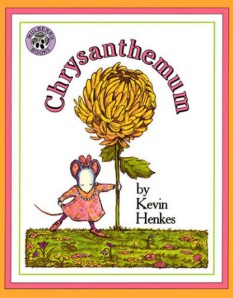
Chrysanthemum by Kevin Henkes is about dealing with bullying when you don't quite fit in.
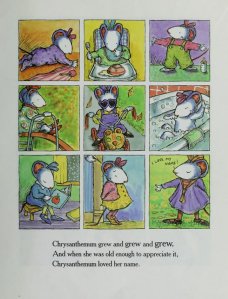
Unfortunately, when Chrysanthemum went to her first day of school, she finds that the other children don't share her high opinion of her name. "It's so long", says Jo. "You're named after a flower!", exclaims Victoria. Chrysanthemum is discouraged.
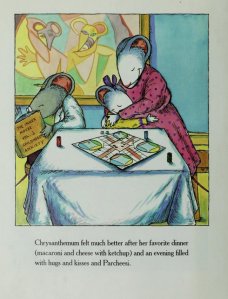
Chrysanthemum's parents reassure her that her name is beautiful--"and precious and priceless and fascinating and winsome"--just like she is. And the other children are simply jealous--"and envious and begrudging and discontented and jaundiced". And who wouldn't be jealous of a name like Chrysanthemum?
When the children tease Chrysanthemum during music class, Mrs. Twinkle, who they especially like, reveals that she, too is named after a flower--Delphinium Twinkle is her name. And she's thinking of naming her child (if it's a girl) Chrysanthemum as well.
Chrysanthemum has a fine story and a good lesson, supported by absolutely charming watercolor illustrations. It's recommended for ages 4-8.
Henkes has also written a number of other picture books featuring mice, including Owen, a Caldecott Honor book.
This review also appears on my blog.
When Chrysanthemum was born, her parents thought she was perfect, and wanted to give her the perfect name. Chrysanthemum loved her name. She loved everything about her name. Until the first day of school, that is. The others don't love her name--it hardly even fits on her name tag! What will poor Chrysanthemum do?

Chrysanthemum by Kevin Henkes is about dealing with bullying when you don't quite fit in.

Chrysanthemum loved her name.
She loved the way it sounded when her mother woke her up.
She loved the way it sounded when her father called her for dinner.
And she loved the way it sounded when she whispered it to herself in the bathroom mirror.
Chrysanthemum, Chrysanthemum, Chrysanthemum.
Unfortunately, when Chrysanthemum went to her first day of school, she finds that the other children don't share her high opinion of her name. "It's so long", says Jo. "You're named after a flower!", exclaims Victoria. Chrysanthemum is discouraged.

Chrysanthemum's parents reassure her that her name is beautiful--"and precious and priceless and fascinating and winsome"--just like she is. And the other children are simply jealous--"and envious and begrudging and discontented and jaundiced". And who wouldn't be jealous of a name like Chrysanthemum?
When the children tease Chrysanthemum during music class, Mrs. Twinkle, who they especially like, reveals that she, too is named after a flower--Delphinium Twinkle is her name. And she's thinking of naming her child (if it's a girl) Chrysanthemum as well.
Chrysanthemum could scarcely believe her ears.
She blushed.
She beamed.
She bloomed.
Chrysanthemum, Chrysanthemum, Chrysanthemum.
Chrysanthemum has a fine story and a good lesson, supported by absolutely charming watercolor illustrations. It's recommended for ages 4-8.
Henkes has also written a number of other picture books featuring mice, including Owen, a Caldecott Honor book.
29Sopoforic
I had never read any of Marc Brown's Arthur books before, so I've been catching up a bit. They're not bad. The artwork really evolves over the first few books, and from the covers of later books I'm guessing that trend continues. Should be interesting to see how the books go, over the years.
Other Reading XXIII: Arthur's Nose by Marc Brown (1976)

The first entry in the venerable Arthur series. Arthur is teased because of his nose, and considers rhinoplasty, but ultimately decides that he's fine just as he is. Not too bad art, decent message. The highlight is Arthur trying on various other animals' noses to see which he likes. Not a bad book, but the series does improve.
Other Reading XXIV: Arthur's Eyes by Marc Brown (1979, 32 pp.)

Second Arthur book. Arthur needs glasses, and is teased because of them. Eventually he learns that they are very helpful, and don't look so bad after all. Better art than the previous book, and generally improved.
Other Reading XXV: Arthur's Valentine by Marc Brown (1980)

Third Arthur book. Nice art, and this one even has a real story. Francine is secretly sending Arthur valentines, but Arthur hopes it might be the new girl, Sue Ellen, sending them. Francine has teased Arthur in the previous books, and he gets her back with a little trick, once he discovers that she is his secret admirer. This is the best Arthur book so far.
Other Reading XXVI: The True Francine by Marc Brown (1981)

The fourth Arthur book, though he scarcely appears. This time, Francine is in the spotlight. It's nice to see her get a positive showing, here. The moral is that honesty is the best policy, but I'm not sure I agree with the book's position that Francine shouldn't reveal when her friend is lying. Loyalty is one thing, but... anyway, it's still a pretty good book, though I liked Arthur's Valentine a bit better.
Other Reading XXIII: Arthur's Nose by Marc Brown (1976)

The first entry in the venerable Arthur series. Arthur is teased because of his nose, and considers rhinoplasty, but ultimately decides that he's fine just as he is. Not too bad art, decent message. The highlight is Arthur trying on various other animals' noses to see which he likes. Not a bad book, but the series does improve.
Other Reading XXIV: Arthur's Eyes by Marc Brown (1979, 32 pp.)

Second Arthur book. Arthur needs glasses, and is teased because of them. Eventually he learns that they are very helpful, and don't look so bad after all. Better art than the previous book, and generally improved.
Other Reading XXV: Arthur's Valentine by Marc Brown (1980)

Third Arthur book. Nice art, and this one even has a real story. Francine is secretly sending Arthur valentines, but Arthur hopes it might be the new girl, Sue Ellen, sending them. Francine has teased Arthur in the previous books, and he gets her back with a little trick, once he discovers that she is his secret admirer. This is the best Arthur book so far.
Other Reading XXVI: The True Francine by Marc Brown (1981)

The fourth Arthur book, though he scarcely appears. This time, Francine is in the spotlight. It's nice to see her get a positive showing, here. The moral is that honesty is the best policy, but I'm not sure I agree with the book's position that Francine shouldn't reveal when her friend is lying. Loyalty is one thing, but... anyway, it's still a pretty good book, though I liked Arthur's Valentine a bit better.
30Sopoforic
It is possible that it's nearly the end of March and I'm only up to 5 on the 'real book' counter? It looks that way. I may have to reschedule my reading, or I'll end the year with 200 picture books and half a novel read. My problem is that I start reading 50 books, and it takes ages to finish them with that many going, while I can finish a picture book in a single sitting. I must learn to focus!
Book 5: The Entropy Effect by Vonda N. McIntyre (1981, 224 pp.)
A little break from all these picture books seems to be in order, so let's go with something completely different: The Entropy Effect by Vonda N. McIntyre, which is #2 in the Pocket Books line of Star Trek novels.
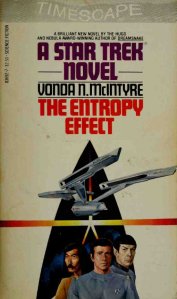
The Enterprise has been in orbit of a singularity for six weeks, Mr. Spock making careful observations of this unusual phenomenon, when they are called away to Aleph Prime by an ultimate override command--to be used only in the most dire of situations.
They arrive to find no great emergency at all. Instead, they're asked to transport a criminal a short distance to a rehabilitation facility. Captain Kirk would have angrily refused, but Spock asks him to accede to this request. It seems that the criminal in question is a scientist of Spock's acquaintance, and there's something fishy about the situation. Spock's investigation uncovers a threat to the entire universe, which he must handle covertly, if he can.
The Entropy Effect focuses on a few characters only: Spock, McCoy, Kirk, and Sulu, plus Mandala Flynn and Hunter, characters original to the novel. The bulk of the novel follows Spock as he deals with the situation, but it takes time to give us some insight into the others, as well. Importantly, in Trek history, it is in this novel that Sulu is given his name, Hikaru (which wouldn't be officially confirmed until a decade later, in The Undiscovered Country), and promised a promotion to lieutenant commander.
The original characters are the high point of the novel. Flynn and the security officers under her command are each interesting: Flynn's desire to prove herself is admirable; Jenniver's difficulties fitting in inspire sympathy; Neon's unusual language (consisting only of nouns) and Snnanagfashtalli's loyalty to Jenniver each merit a mention, as well. Hunter, Kirk's past love, is of little import to the plot, but she does add some needed variety. She has a child, and is part of a nontraditional family arrangement--it's good to show that humans, too, are diverse. There are as many ways to live as there are people on the Earth, and space travel doesn't do anything to simplify that.
Is it odd that each of the characters I identified as being of particular interest is female? Early Trek is certainly a story of men, and this novel, for all its focus on Spock, does somewhat counterbalance that.
The Entropy Effect's plot eventually revolves around time travel, and it's handled fairly well, in a Star Trek sort of way. It's shown to be difficult and far from consequence-free, and there's a bit of suspense as we wonder how (though--let's be honest--not if) Spock will manage his task.
All told, The Entropy Effect is an average book: not great, but fun enough to read once. I understand that several of the original characters show up in other Trek novels; I'll look forward to reading those, some day.
Book 5: The Entropy Effect by Vonda N. McIntyre (1981, 224 pp.)
A little break from all these picture books seems to be in order, so let's go with something completely different: The Entropy Effect by Vonda N. McIntyre, which is #2 in the Pocket Books line of Star Trek novels.

The Enterprise has been in orbit of a singularity for six weeks, Mr. Spock making careful observations of this unusual phenomenon, when they are called away to Aleph Prime by an ultimate override command--to be used only in the most dire of situations.
They arrive to find no great emergency at all. Instead, they're asked to transport a criminal a short distance to a rehabilitation facility. Captain Kirk would have angrily refused, but Spock asks him to accede to this request. It seems that the criminal in question is a scientist of Spock's acquaintance, and there's something fishy about the situation. Spock's investigation uncovers a threat to the entire universe, which he must handle covertly, if he can.
The Entropy Effect focuses on a few characters only: Spock, McCoy, Kirk, and Sulu, plus Mandala Flynn and Hunter, characters original to the novel. The bulk of the novel follows Spock as he deals with the situation, but it takes time to give us some insight into the others, as well. Importantly, in Trek history, it is in this novel that Sulu is given his name, Hikaru (which wouldn't be officially confirmed until a decade later, in The Undiscovered Country), and promised a promotion to lieutenant commander.
The original characters are the high point of the novel. Flynn and the security officers under her command are each interesting: Flynn's desire to prove herself is admirable; Jenniver's difficulties fitting in inspire sympathy; Neon's unusual language (consisting only of nouns) and Snnanagfashtalli's loyalty to Jenniver each merit a mention, as well. Hunter, Kirk's past love, is of little import to the plot, but she does add some needed variety. She has a child, and is part of a nontraditional family arrangement--it's good to show that humans, too, are diverse. There are as many ways to live as there are people on the Earth, and space travel doesn't do anything to simplify that.
Is it odd that each of the characters I identified as being of particular interest is female? Early Trek is certainly a story of men, and this novel, for all its focus on Spock, does somewhat counterbalance that.
The Entropy Effect's plot eventually revolves around time travel, and it's handled fairly well, in a Star Trek sort of way. It's shown to be difficult and far from consequence-free, and there's a bit of suspense as we wonder how (though--let's be honest--not if) Spock will manage his task.
All told, The Entropy Effect is an average book: not great, but fun enough to read once. I understand that several of the original characters show up in other Trek novels; I'll look forward to reading those, some day.
31Sopoforic
And to follow up that Trek novel, a nonfiction book about Trek.
Book 6: Strange and Amazing Facts about Star Trek by Daniel Cohen (1986, 110 pp.)
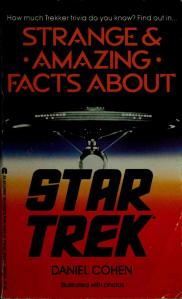
Cohen's book contains facts about Star Trek, but there's nothing strange or amazing therein. The facts are mostly in the form of very brief summaries of a few episodes or (similarly very brief) biographies of a few principal actors. Almost everything in the book will be known to anyone who bothered to watch the show ("When the series begins Kirk is in his mid-thirties, and holds the rank of captain with a starship command."), and the little that might not be is generally of little interest ("Another of Bill Shatner's current enthusiasms is the horses that he rides and breeds on his southern California ranch.").
The most interesting part of this book is the chapter on the fans, which talks about the letter-writing campaign to save Star Trek from cancellation, fanzines, conventions, and the broader impact of Star Trek in the years since its cancellation.
The book concludes with a 22-question trivia quiz.
Stephen E. Whitfield's The Making of Star Trek is by far this book's superior, and even Wikipedia is more informative.
Book 6: Strange and Amazing Facts about Star Trek by Daniel Cohen (1986, 110 pp.)

Cohen's book contains facts about Star Trek, but there's nothing strange or amazing therein. The facts are mostly in the form of very brief summaries of a few episodes or (similarly very brief) biographies of a few principal actors. Almost everything in the book will be known to anyone who bothered to watch the show ("When the series begins Kirk is in his mid-thirties, and holds the rank of captain with a starship command."), and the little that might not be is generally of little interest ("Another of Bill Shatner's current enthusiasms is the horses that he rides and breeds on his southern California ranch.").
The most interesting part of this book is the chapter on the fans, which talks about the letter-writing campaign to save Star Trek from cancellation, fanzines, conventions, and the broader impact of Star Trek in the years since its cancellation.
The book concludes with a 22-question trivia quiz.
Stephen E. Whitfield's The Making of Star Trek is by far this book's superior, and even Wikipedia is more informative.
32scaifea
>23 Sopoforic: I agree that Mei Li is one of the better of the earlier Caldecott winners. The story is charming and the illustrations are lovely.
33Sopoforic
Other Reading XXVII: Arthur Goes to Camp by Marc Brown (1982, 31 pp.)
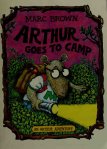
The fifth Arthur book. The art has continued to evolve, and by this point Arthur should look quite familiar to viewers of the TV series. The story is that Arthur goes to camp, is sure that he will hate it--does hate it--but, in the end, he accidentally wins a scavenger hunt for his team, and decides he loves camp. It's meant to be funny, I guess, but it doesn't work for me, and the story's not very interesting. Much boys vs. girls, followed by a new antagonist: an entire camp of villains. Not to my taste.
Other Reading XXVIII: Arthur's Halloween by Marc Brown (1982)

The sixth Arthur book. Halloween themed, obviously, with a rather tired 'old lady who isn't actually a witch, gasp!' plot. Plenty of Arthur being afraid of his shadow, though he does overcome his fear to go after his sister, which is a point in his favor. Most of these books, so far, are about Arthur being afraid or otherwise insecure. Is that what the series is all about? It'd be nice if Arthur could occasionally be a bit more straightforwardly admirable.
Other Reading XXIX: Arthur's April Fool by Marc Brown (1983)
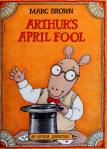
The seventh Arthur book. Another holiday themed book, and we're not done with those yet. Arthur must deal with a bully while preparing for the April Fool's assembly. He's very nervous, but in the end, he manages to play a trick or two on the bully. It's unfortunate that none of the adults around Arthur, including those aware of the bullying, do anything to help, but I expect that's more truth in fiction than anything. Rather average book.
Other Reading XXX: Arthur's Thanksgiving by Marc Brown (1983)
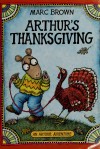
The eighth Arthur book. Arthur is put in charge of the Thanksgiving play. Arthur's friends are extra nice to him, to be sure they get the parts they want. This is nice, until Arthur realizes that nobody wants to play the turkey--and he can't have a play called The Big Turkey Hunt without a turkey! I was expecting a lesson about leadership, or standing up to your friends, or something, but in the end Arthur just plays the turkey himself, and his friends are kind enough to join him in his embarrassment. Disappointing. Another average book.

The fifth Arthur book. The art has continued to evolve, and by this point Arthur should look quite familiar to viewers of the TV series. The story is that Arthur goes to camp, is sure that he will hate it--does hate it--but, in the end, he accidentally wins a scavenger hunt for his team, and decides he loves camp. It's meant to be funny, I guess, but it doesn't work for me, and the story's not very interesting. Much boys vs. girls, followed by a new antagonist: an entire camp of villains. Not to my taste.
Other Reading XXVIII: Arthur's Halloween by Marc Brown (1982)

The sixth Arthur book. Halloween themed, obviously, with a rather tired 'old lady who isn't actually a witch, gasp!' plot. Plenty of Arthur being afraid of his shadow, though he does overcome his fear to go after his sister, which is a point in his favor. Most of these books, so far, are about Arthur being afraid or otherwise insecure. Is that what the series is all about? It'd be nice if Arthur could occasionally be a bit more straightforwardly admirable.
Other Reading XXIX: Arthur's April Fool by Marc Brown (1983)

The seventh Arthur book. Another holiday themed book, and we're not done with those yet. Arthur must deal with a bully while preparing for the April Fool's assembly. He's very nervous, but in the end, he manages to play a trick or two on the bully. It's unfortunate that none of the adults around Arthur, including those aware of the bullying, do anything to help, but I expect that's more truth in fiction than anything. Rather average book.
Other Reading XXX: Arthur's Thanksgiving by Marc Brown (1983)

The eighth Arthur book. Arthur is put in charge of the Thanksgiving play. Arthur's friends are extra nice to him, to be sure they get the parts they want. This is nice, until Arthur realizes that nobody wants to play the turkey--and he can't have a play called The Big Turkey Hunt without a turkey! I was expecting a lesson about leadership, or standing up to your friends, or something, but in the end Arthur just plays the turkey himself, and his friends are kind enough to join him in his embarrassment. Disappointing. Another average book.
34Sopoforic
Other Reading XXXI: E-Mail by Larry Dane Brimner (1997)
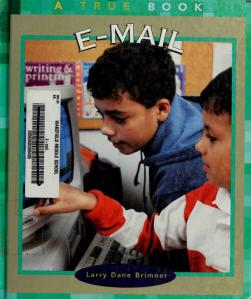
Cast your mind back, all the way to the year 1997. There were some 50 million people with access to the internet, and nearly 10 million of them used America Online. We were so naive as to unironically call the web the 'information superhighway.' Google was brand new, and we mostly used Yahoo, Lycos, or Altavista to search the web. Facebook wasn't even a glimmer in Mark Zuckerberg's 13-year-old eye. We didn't have Twitter or Tumblr, or even Myspace or Livejournal.
What we did have was email. Back then, we hyphenated it, as a sign of respect for and discomfort with the impressive technology. "E-mail is delivered much faster than regular mail (which some people call 'snail-mail')," writes Brimner. "A keypal in another state or even another country usually will receive your e-mail in minutes. That's great news!"
All of this internet stuff was new enough to most people that books were written to introduce people to the subject. The older set had books like World Wide Web for SeniorZ or Mr. Modem's Internet Guide for Seniors, the slightly younger crowd had A Parent's Guide to the Internet, and kids had books like this one, Larry Dane Brimner's E-Mail.
E-Mail is full of the kind of advice that most of us take for granted, these days. For example, you'll need a network card or modem, which will "take the signals from your computer and get messages ready to travel over the Information Superhighway." Brimner helpfully provides a picture of an IBM 7852 model 10 modem, which around that time had dropped in price to only $486.
It's also got the kind of information we probably should know, but might need to keep in mind: "If you are not careful, you might write and send angry words to somebody else and later wish you hadn't." Truth.
E-Mail explains what a flame war is, how to find and subscribe to mailing lists, what emoticons are, and much more. Sprinkled throughout are e-mail addresses that kids might want to try, like Sea World (sea.world@bev.net), the USGS (Ask-A-Geologist@usgs.gov), or the President of the United States (president@whitehouse.gov). The author even includes his own email address (Lbrimner@aol.com).
This book is certainly a product of its time. Besides the screenshots of Eudora circa 1996, it's got a dated approach to dealing with people you meet on the internet. "Most of the people you'll meet on the Internet are nice. But be smart. Bad people sometimes hide out on the Internet, and you may not be able to tell who they are . . . If your keypal wants to meet you in person, meet in a public place like a mall. And take an adult with you."
If that advice had been written today, I imagine it'd go more like "If your keypal wants to meet you in person, run. Don't stop until you're surrounded by police. Make sure the police have never used the internet. It's the only way to be sure."
Books like E-Mail are fascinating as a view back into how we thought about technology in the past. It's been about 17 years since this book was published. In some ways, it's still perfectly correct and even useful. In others, it's hopelessly dated. How will things look in 2031? I don't dare to guess.

Cast your mind back, all the way to the year 1997. There were some 50 million people with access to the internet, and nearly 10 million of them used America Online. We were so naive as to unironically call the web the 'information superhighway.' Google was brand new, and we mostly used Yahoo, Lycos, or Altavista to search the web. Facebook wasn't even a glimmer in Mark Zuckerberg's 13-year-old eye. We didn't have Twitter or Tumblr, or even Myspace or Livejournal.
What we did have was email. Back then, we hyphenated it, as a sign of respect for and discomfort with the impressive technology. "E-mail is delivered much faster than regular mail (which some people call 'snail-mail')," writes Brimner. "A keypal in another state or even another country usually will receive your e-mail in minutes. That's great news!"
All of this internet stuff was new enough to most people that books were written to introduce people to the subject. The older set had books like World Wide Web for SeniorZ or Mr. Modem's Internet Guide for Seniors, the slightly younger crowd had A Parent's Guide to the Internet, and kids had books like this one, Larry Dane Brimner's E-Mail.
E-Mail is full of the kind of advice that most of us take for granted, these days. For example, you'll need a network card or modem, which will "take the signals from your computer and get messages ready to travel over the Information Superhighway." Brimner helpfully provides a picture of an IBM 7852 model 10 modem, which around that time had dropped in price to only $486.
It's also got the kind of information we probably should know, but might need to keep in mind: "If you are not careful, you might write and send angry words to somebody else and later wish you hadn't." Truth.
E-Mail explains what a flame war is, how to find and subscribe to mailing lists, what emoticons are, and much more. Sprinkled throughout are e-mail addresses that kids might want to try, like Sea World (sea.world@bev.net), the USGS (Ask-A-Geologist@usgs.gov), or the President of the United States (president@whitehouse.gov). The author even includes his own email address (Lbrimner@aol.com).
This book is certainly a product of its time. Besides the screenshots of Eudora circa 1996, it's got a dated approach to dealing with people you meet on the internet. "Most of the people you'll meet on the Internet are nice. But be smart. Bad people sometimes hide out on the Internet, and you may not be able to tell who they are . . . If your keypal wants to meet you in person, meet in a public place like a mall. And take an adult with you."
If that advice had been written today, I imagine it'd go more like "If your keypal wants to meet you in person, run. Don't stop until you're surrounded by police. Make sure the police have never used the internet. It's the only way to be sure."
Books like E-Mail are fascinating as a view back into how we thought about technology in the past. It's been about 17 years since this book was published. In some ways, it's still perfectly correct and even useful. In others, it's hopelessly dated. How will things look in 2031? I don't dare to guess.
35Sopoforic
Other Reading XXXII: The True Story of the 3 Little Pigs! by Jon Scieszka and Lane Smith (1989)
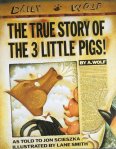
An ALA Notable Book. Scieszka lets the wolf tell his own story in this fractured fairy tale. Alexander T. Wolf–who scurrilous media reports have dubbed “the Big Bad Wolf”–isn’t such a bad guy. He just wanted to borrow a cup of sugar from his neighbors, the pigs, but was overcome by a terrible sneezing cold. An amusing take on the story, with excellent illustrations. This book was the first of many collaborations between Scieszka and Smith.
Other Reading XXXIII: Blueberries for Sal by Robert McCloskey (1948)
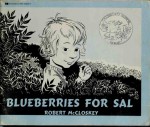
A Caldecott Honor Book. Sal and her mother go out to pick blueberries to store for the winter. A bear cub and its mother have the same idea, and the mothers and children get mixed up. Excellent line art and a cute story. The parallel between the bears storing up fat for the winter and the humans preserving blueberries is a good one, and their actions, too, parallel one another satisfyingly.

An ALA Notable Book. Scieszka lets the wolf tell his own story in this fractured fairy tale. Alexander T. Wolf–who scurrilous media reports have dubbed “the Big Bad Wolf”–isn’t such a bad guy. He just wanted to borrow a cup of sugar from his neighbors, the pigs, but was overcome by a terrible sneezing cold. An amusing take on the story, with excellent illustrations. This book was the first of many collaborations between Scieszka and Smith.
Other Reading XXXIII: Blueberries for Sal by Robert McCloskey (1948)

A Caldecott Honor Book. Sal and her mother go out to pick blueberries to store for the winter. A bear cub and its mother have the same idea, and the mothers and children get mixed up. Excellent line art and a cute story. The parallel between the bears storing up fat for the winter and the humans preserving blueberries is a good one, and their actions, too, parallel one another satisfyingly.
36scaifea
I'm not really a fan of Scieszka, but McCloskey is a different story - absolutely love Blueberries for Sal.
37Sopoforic
Other Reading XXXIV: Wacky Wednesday by Theo. LeSieg and George Booth (1974)
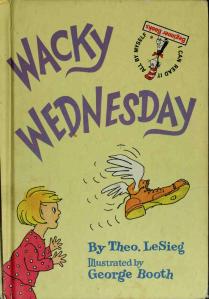
Dr. Seuss both wrote and illustrated his most famous works, but he did create a few books illustrated by others, usually using a pseudonym. He wrote Wacky Wednesday under the name Theo. LeSieg--his own name, Theodore Geisel, turned around. It was illustrated by George Booth.
Wacky Wednesday tells of one Wednesday when everything was wacky: shoes on the wall, bananas growing on an apple tree, worms chasing birds, and much more. Seuss's text is very much secondary to Booth's illustrations. The text of each two-page spread announces the number of things that are 'wacky' in the accompanying illustration, inviting the reader to find them all.
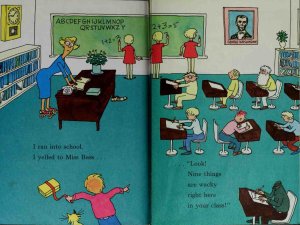
The number of wacky things in each scene increases as the book goes along, culminating in a final two-page spread with twenty wacky things:
The type of wackiness varies, exercising different skills: counting (how many wacky things have we found?), spelling ('schoul' is not the right way to spell 'school'), domain knowledge (a portrait of Abraham Lincoln should not be labelled 'George Washington'), and simple attention to detail (turtles do not belong atop trees!).
Wacky Wednesday is a great book that encourages participation from the reader. It's appropriate for April Fool's Day or any day.

It all began with that shoe on the wall. A shoe on a wall . . . ? Shouldn't be there at all!
Then I looked up. And I said, "Oh, MAN!"
And that's how Wacky Wednesday began.
Dr. Seuss both wrote and illustrated his most famous works, but he did create a few books illustrated by others, usually using a pseudonym. He wrote Wacky Wednesday under the name Theo. LeSieg--his own name, Theodore Geisel, turned around. It was illustrated by George Booth.
Wacky Wednesday tells of one Wednesday when everything was wacky: shoes on the wall, bananas growing on an apple tree, worms chasing birds, and much more. Seuss's text is very much secondary to Booth's illustrations. The text of each two-page spread announces the number of things that are 'wacky' in the accompanying illustration, inviting the reader to find them all.

The number of wacky things in each scene increases as the book goes along, culminating in a final two-page spread with twenty wacky things:
"Only twenty things more will be wacky," he said.
"Just find them and then you can go back to bed."
The type of wackiness varies, exercising different skills: counting (how many wacky things have we found?), spelling ('schoul' is not the right way to spell 'school'), domain knowledge (a portrait of Abraham Lincoln should not be labelled 'George Washington'), and simple attention to detail (turtles do not belong atop trees!).
Wacky Wednesday is a great book that encourages participation from the reader. It's appropriate for April Fool's Day or any day.
38Sopoforic
I kept meaning to come back and update this thread, but I didn't want to list books without reviewing them, and the months went by, and here we are. For a sense of closure, I'll give an estimate here, and try to do better next year.
Part 1: Real Books
This mostly means not picture books, though I did include one in this list, since it's part of my project to read Caldecott Medal winners.
Part 2: Not-a-books
Actually, these mostly are books, but they're also mostly picture books.
Part 3: Others, not listed separately
I didn't keep track of all the manga, light novels, and other stuff that I read, but here's a sample of what I do have written down.
Part 4: Summary
16 books, 43 'not-a-books', and (rather more than) 44 volumes of manga. Strictly by the numbers, I could say that I read (at least) 103 books and call this a success, but really I didn't read most of the books I had set aside for this year and most of what I did read was the kind of thing I had originally intended not to count, so...
I'll try to do better in 2015.
Part 1: Real Books
This mostly means not picture books, though I did include one in this list, since it's part of my project to read Caldecott Medal winners.
- A Boy's Will by Robert Frost (1913, 63 pp.)
- North of Boston by Robert Frost (1914, 143 pp.)
- Born to Run by Mercedes Lackey and Larry Dixon (1992, 336 pp.)
- Animals of the Bible: A Picture Book by Dorothy P. Lathrop (1937, 65 pp.)
- The Entropy Effect by Vonda N. \McIntyre (1981, 224 pp.)
- Strange and Amazing Facts about Star Trek by Daniel Cohen (1986, 110 pp.)
- Teach Like Socrates: guiding Socratic dialogues and discussions in the classroom by Erick Wilberding (2014)
- Mushoku Tensei ~Isekai Ittara Honki Dasu~ 1 by Rifujin na Magonote and Shirotaka (2014)
- Star Trek by James Blish (1967, 136 pp.)
- Mission to Horatius by Mack Reynolds (1968, 210 pp.)
- Star Trek 2 by James Blish (1968, 122 pp.)
- Star Trek 3 by James Blish (1969, 118 pp.)
- Spock Must Die! by James Blish (1970, 118 pp.)
- Star Trek 4 by James Blish (1971)
- The Making of Star Trek by Stephen E. Whitfield (1968)
- Mountain Interval by Robert Frost (1916)
Part 2: Not-a-books
Actually, these mostly are books, but they're also mostly picture books.
- My Winter-Garden by Charles Kingsley
- Cherries and Cherry Pits by Vera B. Williams (1986, 36 pp.)
- The Worm by Elise Gravel (2014, 32 pp.)
- The Sagebrush Singers by Herbert Kernecker (2014, 34 pp.)
- The Powerpuff Girls Volume 1 by Troy Little (2014, 128 pp.)
- Amazing Grace by Mary Hoffman and Caroline Binch (1991, 24 pp.)
- Wise Grandma Duck (1985, 40 pp.)
- Oh, Were They Ever Happy! by Peter Spier (1989)
- The Girl Who Loved Wild Horses by Paul Goble (1978)
- The Relatives Came by Cynthia Rylant (1985)
- Boundless Grace by Mary Hoffman (1995)
- Ira Sleeps Over by Bernard Waber (1972)
- Rosie's Walk by Pat Hutchins (1968)
- Hey, Al by Arthur Yorinks (1986)
- How My Parents Learned to Eat by Ina R. Friedman (1984)
- Welcome Back, Snow White (1986, 48 pp.)
- The Bully Goat Grim by Willy Claflin and James Stimson (2012, 39 pp.)
- Mei Li by Thomas Handforth (1938, 44 pp.)
- Grimm Fairy Tales presents Oz by Joe Brusha (2014, 153 pp.)
- My Book About Me, By Me Myself by Dr. Seuss and Roy \McKie (1969)
- Wings on Things by Marc Brown (1982)
- Chrysanthemum by Kevin Henkes (1991, 30 pp.)
- Arthur's Nose by Marc Brown (1976)
- Arthur's Eyes by Marc Brown (1979, 32 pp.)
- Arthur's Valentine by Marc Brown (1980)
- The True Francine by Marc Brown (1981)
- Arthur Goes to Camp by Marc Brown (1982, 31 pp.)
- Arthur's Halloween by Marc Brown (1982)
- Arthur's April Fool by Marc Brown (1983)
- Arthur's Thanksgiving by Marc Brown (1983)
- E-Mail by Larry Dane Brimner (1997, 47 pp.)
- The True Story of the 3 Little Pigs! by Jon Scieszka and Lane Smith (1989, 32 pp.)
- Blueberries for Sal by Robert McCloskey (1948)
- Wacky Wednesday by Theo. LeSieg & George Booth (1974)
- Robert Frost Country by Betsy and Tom Melvin (1977)
- The Dot and the Line: A Romance in Lower Mathematics by Norton Juster (1963, 64 pp.)
- Mr. Rabbit and the Lovely Present by Charlotte Zolotow & Maruice Sendak (1963)
- Harold's ABC by Crockett Johnson (1963)
- A Chair for My Mother by Vera B. Williams (1982)
- Stellaluna by Janell Cannon (1993)
- Arthur's Christmas by Marc Brown (1984)
- Batman: Night Cries by Archie Goodwin (1998)
- Freddi Fish: The Big Froople Match by Dave Grossman (2000)
Part 3: Others, not listed separately
I didn't keep track of all the manga, light novels, and other stuff that I read, but here's a sample of what I do have written down.
- Akagi: Yami ni Oritatta Tensai by Nobuyuki Fukumoto (8 volumes)
- Hourou Musuko by Takako Shimura (15 volumes)
- Akuma Jiten by Shinya Suyama (2 volumes)
- Jin by Motoka Murakami (6 volumes)
- Penguin Kakumei by Tsukuba Sakura (6 volumes)
- Koe no Katachi by Ooima Yoshitoki (7 volumes)
Part 4: Summary
16 books, 43 'not-a-books', and (rather more than) 44 volumes of manga. Strictly by the numbers, I could say that I read (at least) 103 books and call this a success, but really I didn't read most of the books I had set aside for this year and most of what I did read was the kind of thing I had originally intended not to count, so...
I'll try to do better in 2015.

